REMEMBERING LEONG HO SAN

3 September 1941 – 10 April 2023
This is a humble tribute to one of the star-servants of our time who made Baháʼu’lláh the centre of his life in both his thoughts and deeds. To please the heart of the Blessed Beauty was the motto in his life, which he had demonstrated at every phase of his life. This story captures the salient aspects of his services to the Cause.
Leong Ho San or Ho San as he was popularly known, grew up in the family home at 21, Pengkalan Rama Road, and later moved to 61, St. John’s Hill, both in Malacca town. Among the seven children in the family- four girls and three boys, Ho San was the second youngest. He belonged to a family that was deeply steeped in Taoist traditions and rituals and followed religious customs inculcated by priests in the Chinese temples and participated in numerous festivals. They burned joss sticks and incense papers and offered food at the altars of the gods whom they prayed to. Ancestor worship was an integral part of the life of the family. To Ho San, all these did not make any sense, but he followed them out of obedience to his elders. But all that was to change when the glorious Faith of Baháʼu’lláh wafted over him.
LEONG TAT CHEE – A SPIRITUAL FATHER AS WELL
His father Leong Tat Chee, wanted to know more about the meaning of life and its purpose, not just blindly follow ancestral practices that did not provide clear meaning. Leong Tat Chee subscribed to newsletters and books of the Theosophist Society and the Rosicrucian. He also studied the Bible and the Holy Quran. Young American missionaries from the Methodist, Mormon, and Jehovah Witness Churches would visit their home on Sundays to give Bible lessons. But nothing materialized out of this, and the family continued their Buddhist and Taoist ways of worshipping. In 1954, Leong Tat Chee saw an advertisement in the local newspaper about a Bahá’í fireside. Aroused by curiosity he went to the meeting and heard about the teachings of a new religion, the Bahá’í Faith, from Dr. K. M. Fozdar and his dearly loved wife Shirin. The Fozdars were amongst the very first pioneers to both Singapore and Malaya. In 1953, the Fozdars moved to Malacca when Dr. K.M. Fozdar was offered a job as a medical doctor at a local medical clinic. After some months of soul-searching attempts, he entered into heated discussions and arguments mainly with Dr. Fozdar, who threw a challenge at him to really study the Writings. Armed with several books borrowed from Dr. Fozdar, Leong Tat Chee took leave from his work for 2 weeks or so, secluded himself in his room and began his intense studies. He emerged as a believer in the Baháʼí Faith. Afire with a vehement love for the Faith, Leong Tat Chee wanted his wife and children to know about it. Night and day, seven days a week, the family members were taught the salient teachings mainly at meal times. His house served as a meeting place for the Baháʼís. Leong Tat Chee was direct in his approach, talking about the Faith almost non-stop. Ho San was quite annoyed with this, but he too made up his mind to go through Baháʼí books and ended up reading a few such as ‘Bahá’u’lláh and the New Era’, ‘Renewal of Civilization’ and ‘The Promised Day is Come’. He was intrigued by the teaching on Progressive Revelation and the term ‘Manifestation of God’ referring to Bahá’u’lláh struck a chord and was deeply moved. On 20 October 1957, on the occasion of the Birthday of the Báb, Ho San accepted the Faith and just like his father, he too was on fire with the love for the Faith. That was a turning point in his life, and he set to consecrate his entire life for Baháʼu’lláh. Meanwhile before and after him all his family members accepted the Faith one after the other. The Leong family went on to become devoted servants of the Faith in Malacca, at that time the leading Baháʼí community in Malaya.
MEETING HANDS OF THE CAUSE
Ho San was one of the believers of Malaya who had met many Hands of the Cause of God, starting with Dr. Rahmatu’lláh Muhájir. Ho San attained the presence of the Hand of the Cause of God Dr. Muhájir in December 1957 when the latter came for the first Summer School held in the country. Thereafter, he had the bounty of meeting many other Hands who all had lasting impacts on him. With the untimely passing of the Guardian in November 1957, the appointment of Hands of the Cause ended. But Ho San was blessed with attaining the presence of several Hands both in Malaysia and abroad.
WELL-GROUNDED IN THE CAUSE
Malacca was the first community that organized Sunday Bahá’í Classes for the students at the Malacca High School. Ho San was one of the many Bahá’í youth who were students at the Malacca High School to be deepened by two teachers – Kumara Das and G. Saurajen as well Anthony Louis a Technical Assistant with the Public Works Department who conducted those Sunday Bahá’í Classes. This was the single most important event that deepened the youth of Malacca and they all became great servants of the Cause in later years. The Sunday Bahá’í Classes were foundation-laying classes for them, a privilege not all communities had in the late 1950s.

Ho San attended the Sunday Classes conducted in 1958. Seen here is G. Saurajen conducting a class.
SERVED AS A FAMILY
Ho San’s family members became teachers of the Faith and served the Cause in their own ways. Within the state of Malacca, Ho San was a grassroots worker for the Cause, teaching in the districts of Jasin, Masjid Tanah, and Alor Gajah. When Ho San passed his driver’s license test in 1958, he assisted whenever possible in driving his parents to these areas particularly where the rubber plantation settlements or estates were located, and many accepted the Faith. His other teaching companions were Tushar Kanti-Paul and Raymond Peter with whose assistance he covered several rubber estates. His home became an epicenter for Baháʼí activities in Malacca – ranging from deepening classes to holding Nineteen Day Feasts and observing Holy Days. Of that period of the Ten-Year Crusade (1957 to 1963) Ho San says, “It was a soul-stirring time, very special and remarkable, when the Faith took root in the country and grew almost like wildfire. It was a wonderfully exciting time and for those of us who found the Faith and became among its early believers there was almost a messianic fervour to teach and grow and spread the Bahá’í Teachings everywhere in the country and to learn as much as we could and champion its Cause.”
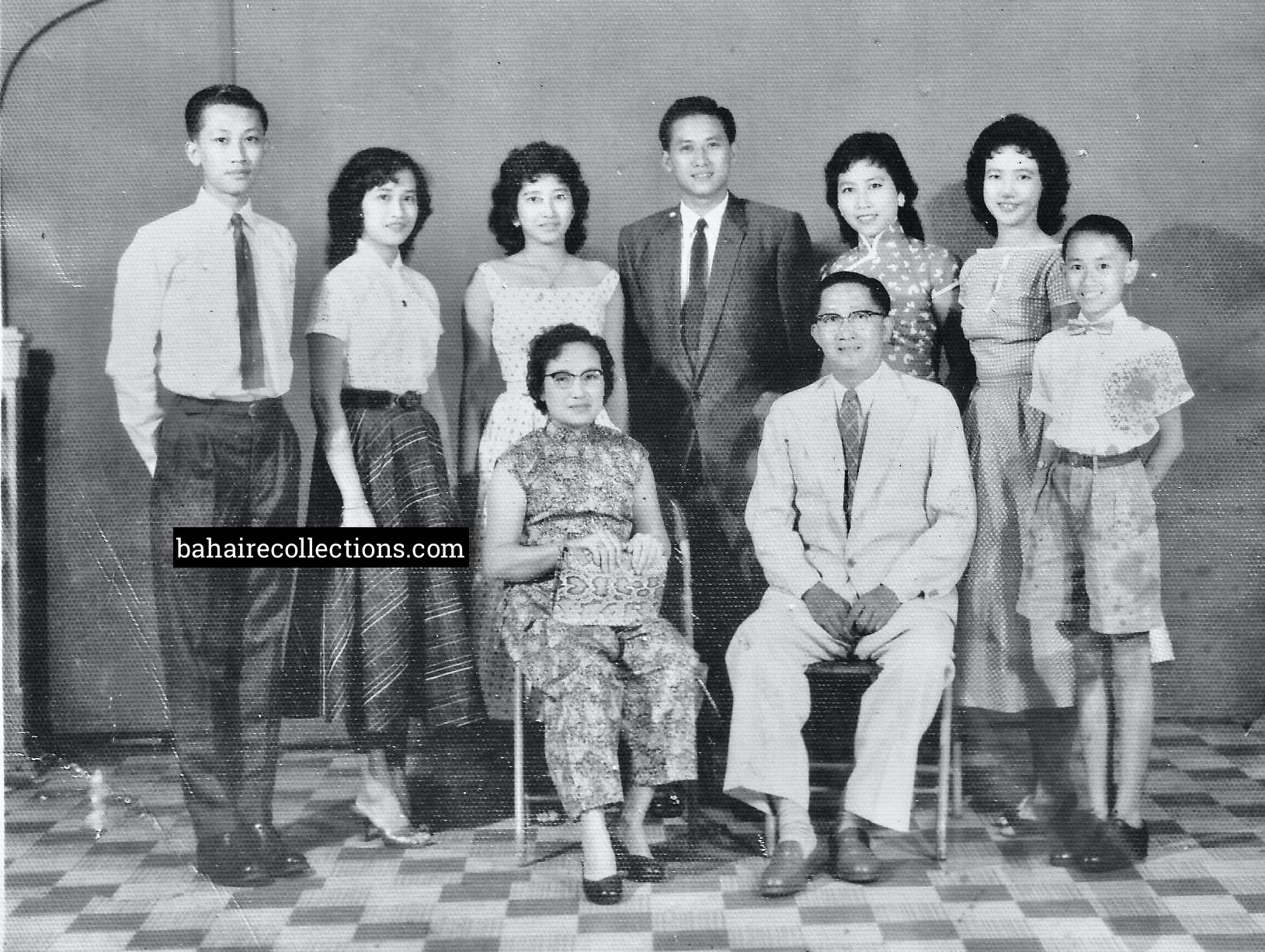
The Leong family photo taken in 1957. Each served the Faith with distinction.

Gathering of some believers at the Boy Scout’s Hall in Malacca town, 1958. Kumara Das is in the middle with black necktie. Anthony Louis is squatting at the extreme right. Koh Ai Leen is standing at the extreme right. Lily is standing third from right, Raymond Peter stands eighth from right. Leong Ho San is standing fifth from the left. The three squatting from left are Pijush Kanti Paul, Tushar Kanti-Paul and Jami Subramaniam.
INTERCONTINENTAL CONFERENCE
Having accepted the Faith in October 1957, Ho San was privileged to be exposed to some never to be repeated events. In September 1958, there was the Intercontinental Conference held in the Victoria Memorial Hall in Singapore. That was the first international conference in the region. He was one of those early batch of 30 believers in Malaya to have participated in the Conference. For Ho San, it was the very first time that he witnessed such a large diverse gathering of Bahá’ís from all over the world and experienced the love and unity and saw the Faith in action. The presence of nine Hands of the Cause of God was the greatest privilege for him as their talks delivered at the Conference created a deep and lasting impact and impression in his soul. It was here that he lined up with the other conference participants and in utter reverence, viewed the photograph of Baháʼu’lláh for the first time. Ho San returned to Malacca with a renewed zeal to serve the Cause with even greater vigor.

Intercontinental Conference held in Singapore and graced by nine Hands of the Cause of God.
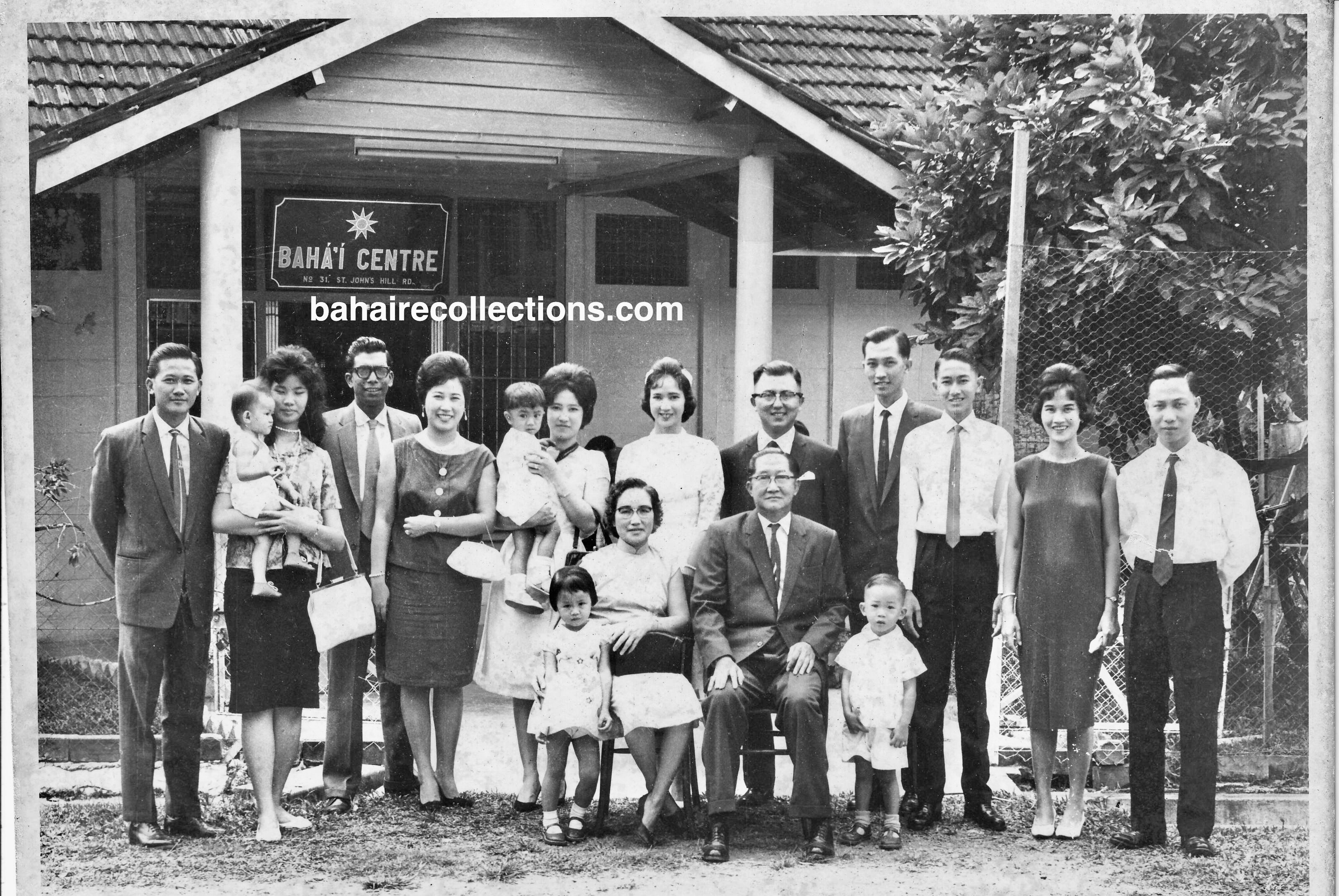
A photo of the Leong family, 1961.
THE FIRST BAHÁʼÍ WORLD CONGRESS
The next event that moved him was the First Baháʼí World Congress held in the Royal Albert Hall in London from 28 April to 02 May 1963. The Congress that has a unique and unparalleled place in our history was convened for the celebration of the completion of the Ten-Year Crusade coinciding with the Centenary of the Declaration of Bahá’u’lláh and the election of the First Universal House of Justice. The First Bahá’í World Congress was often referred to as ‘The Most Great Jubilee’. Ho San was among the over 6,500 believers from every corner of the world. It was a heavenly feast for his eyes and the spirit! Ho San said, “One moment I was myself, and the next moment I was part of a huge crowd. I wish you were there to share this wonderful experience of being in a different world.”
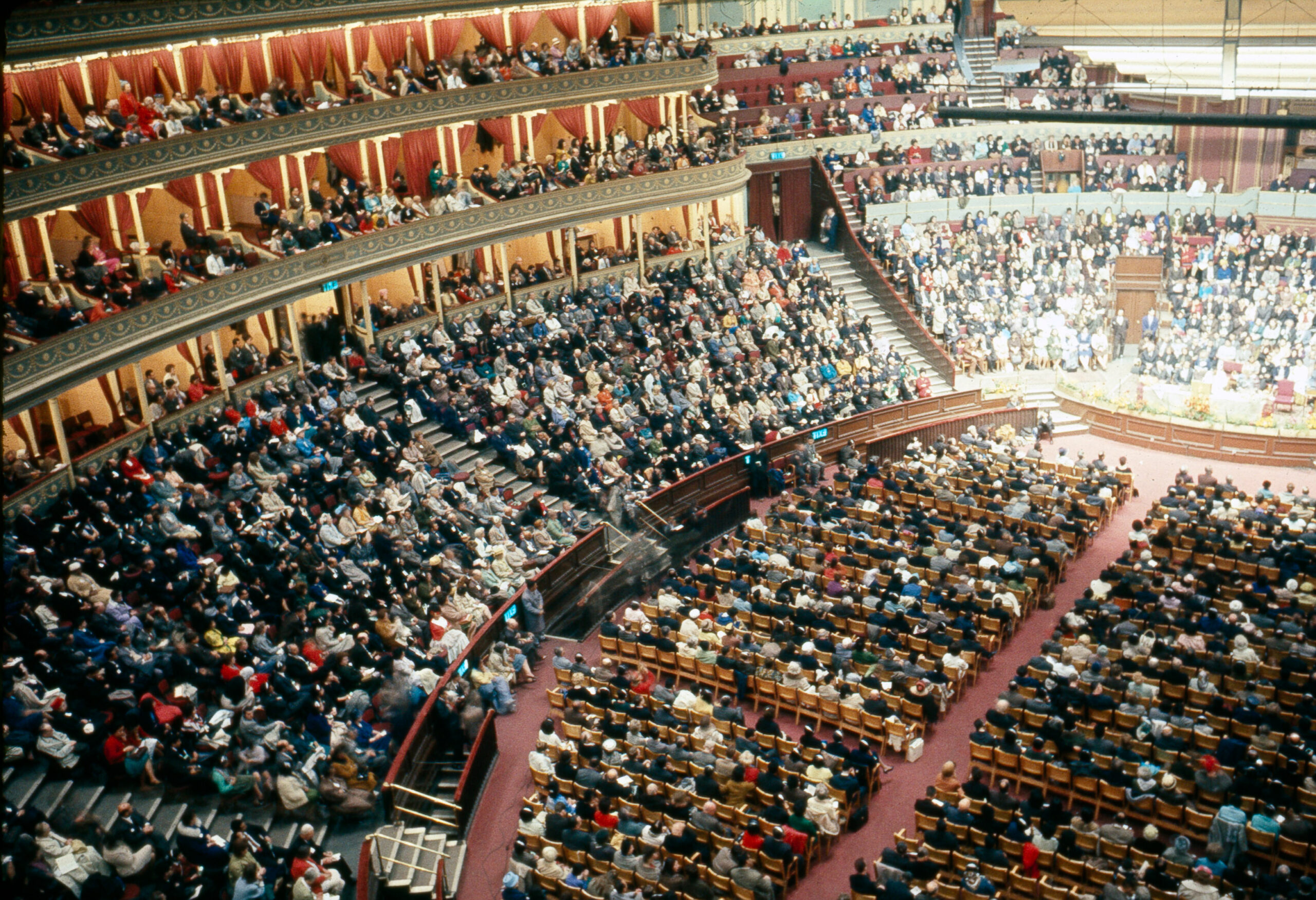 First Baháʼí World Congress in London, 1963, attended by some 6,500 believers from across the globe.
First Baháʼí World Congress in London, 1963, attended by some 6,500 believers from across the globe.
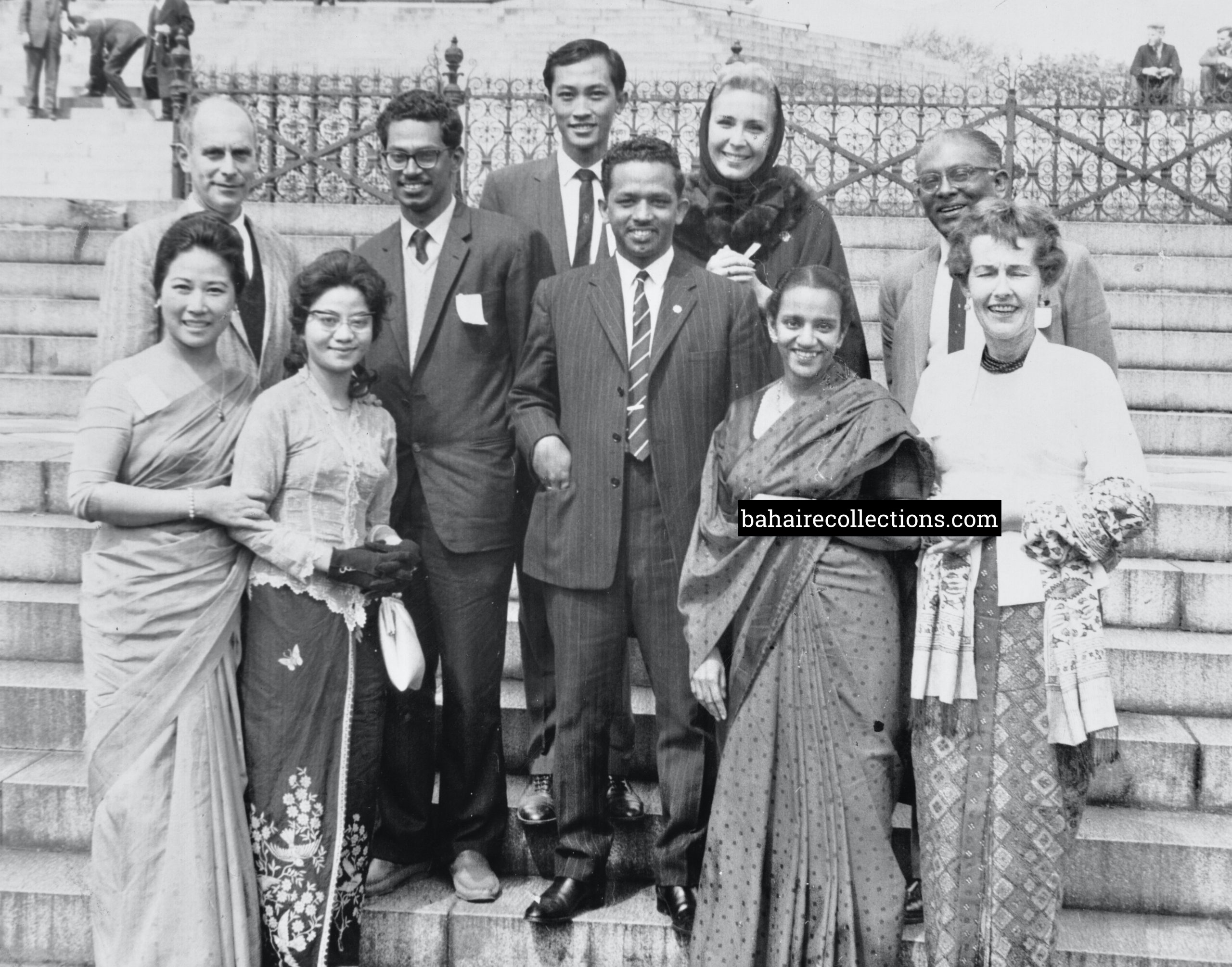 Part of the Malayan delegation at the First Baháʼí World Congress- Back Row L-R: Dr. R. J. Wolff, S. Bhaskaran, Leong Ho San, Jeanne Frankel and Appu Raman. First Row L-R: Lily Chinniah, Chiang Kim Lin, E. A. Fernandez, Shantha Sundram and Elinor Wolff.
Part of the Malayan delegation at the First Baháʼí World Congress- Back Row L-R: Dr. R. J. Wolff, S. Bhaskaran, Leong Ho San, Jeanne Frankel and Appu Raman. First Row L-R: Lily Chinniah, Chiang Kim Lin, E. A. Fernandez, Shantha Sundram and Elinor Wolff.
A DYNAMIC YOUTH
Ho San was one of the earliest youth to have been a member of Youth Committees, starting in Malacca and later in Kuala Lumpur. He was the treasurer of the Youth Committee of Malacca in 1961. In the same year, he came to pursue a science degree at the University Malaya and stayed with his elder brother Leong Ho Chiew who had been transferred from Malacca to Kuala Lumpur in 1960. He became an active member of the Kuala Lumpur Youth Committee. In 1961, Leong Ho Chiew was transferred to Petaling Jaya and Ho San too followed him. Both brothers became a great strength in building the upcoming Petaling Jaya community. In October 1962, the Local Spiritual Assembly of Petaling Jaya was formed with Ho San, aged 21 being elected the Secretary. On 6 October 1963, the youth of Seremban town organised a Regional Youth Conference. Ho San, pursuing a science degree at University Malaya and actively teaching the Asli people made a plea to everyone at the conference to help the Asli believers who were undergoing mistreatment by some ignorant local authorities. In the English group, there was a written test on the Bahá’í Administration. It was no surprise that Ho San already well-grounded in the Faith by avid reading of Baháʼí literature won the first prize.
AN EARLY ASLI TEACHER
Ho San has the distinction of being one of the earliest to enter into the Malayan jungles to teach the aboriginal people from 1962 while residing in Petaling Jaya. In 1962, Dr. Robert J. Wolff, a medical officer from Hawaii, and his wife Elinor Wolff came to Petaling Jaya. Dr. Wolff was a nutrition expert from the World Health Organisation who came to Malaya to study the dietary habits of the aboriginal people and lived in a rented bungalow at 9, Road 5/35, Petaling Jaya. Dr. Wolff went into the Malayan jungles on a two-fold mission- to learn of the dietary habits of the aboriginal people and teach them the Faith. Ho San often joined Dr. Wolff in making many trips to the Asli areas and living with them on occasion. Of his teaching in the aboriginal jungles, Ho San says, “In the early 1960s I had spent many a weekend in Kampong Chang in the state of Perak where the aboriginal people lived. There was a fairly large Bahá’í community then and I really enjoyed the experience of their simple village life, unspoilt in many ways. There were also other small villages that were close by easily reached by road, and they too heard of the Faith and became its early believers. One Mr. Deraoh bin Leman was the most active Asli believer at that time and became the first Asli travel teacher from among the Asli believers. I took him to visit the Bahá’í community of Penang in 1963. He was also the only Asli believer to have attended the First Bahá’í World Congress in London in 1963.”
In 1964, just before the National Spiritual Assembly of Malaysia was elected, the Regional Spiritual Assembly for South East Asia, the administrative body governing the affairs of several countries in the region, formed the first Aborigine Teaching Committee. Dr. Robert J. Wolff, Ho San, and K. Krishnan (Postman Krishnan) of Seremban served on the committee. And when the first National Convention took place in 1964, Ho San spoke on the topic of “Aborigines of Malaysia” in the presence of the delegates and Amatu’l-Bahá Rúhíyyih Khánum who was the official representative of the Universal House of Justice.
BAHÁʼÍ HOUSE OF WORSHIP IN FRANKFURT
From 1964 to 1968 Ho San was blessed with several events. In 1964, he entered a national radio quiz competition in Kuala Lumpur sponsored by Unilever Malaysia, offering a return trip to London for two and a winner’s prize of M$1000, and to his utter surprise he won. There was no one he could take with him and so it was in June 1964 that he left for Bangkok as the major stopover, spending several days with Mrs. Shirin Fozdar and visiting the friends in that ever-growing city. In early July 1964, Ho San had the good fortune to attend the dedication of the Bahá’í House of Worship in Frankfurt. He was the only Malaysian at the inauguration of the House of Worship, the dedication service which was conducted by Hand of the Cause Amatu’l-Bahá Rúḥíyyih Khánum in the presence of some 300 believers who came from all over the world. He, along with the 300 participants had the special bounty and privilege of viewing the photograph of Bahá’u’lláh which was again was an unforgettable experience, as they all lined up in reverence waiting for their turn. That was the second time Ho San viewed the photograph of Baháʼu’lláh, the first being at the Inter-Continental Conference in Singapore in September 1958.
Following the dedication of the House of Worship, Ho San received an invitation to visit the family home of Hand of the Cause of God Dr. Herman Grossmann located in the lovely village of Neckargemünd in Germany. The Hand of the Cause was unfortunately not well but Ho San managed to meet him when the family gathered together for the commemoration of the Martyrdom of the Báb on 9 July. He had the privilege to exchange words of greeting and shake hands with him. He and his wife were most gracious hosts, sharing stories of the years they spent in South America as pioneers.
His final stopover was London and shortly after arrival, he quickly made his way to the Harlech Summer School in Wales. Ho San ended up staying just over 4 years in England. Over the next 3 to 4 years, he met many friends at summer schools, weekend teaching conferences, and other activities held in different places.
He applied for a job with the Midlands Electricity Board in Wolverhampton in the Midlands and was selected from approximately 150 applicants. He was offered the job which really surprised him. He was with them for a year and a half and then moved on.
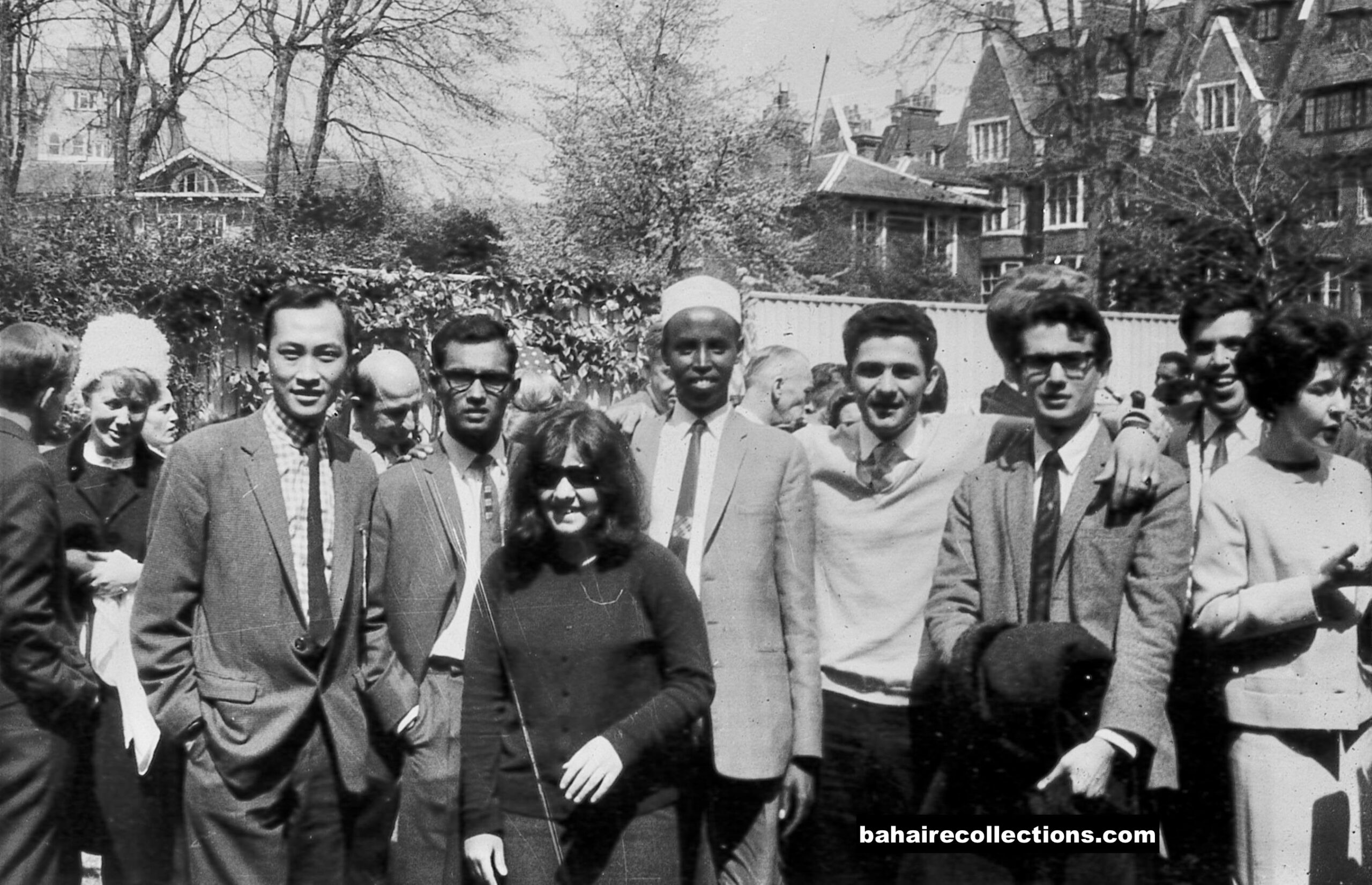 Ho San at the left, in the United Kingdom in 1964.
Ho San at the left, in the United Kingdom in 1964.
FIRST PILGRIMAGE OF A RARE KIND
Ho San’s first pilgrimage took place in November 1964, while still in the United Kingdom. That was a high point in his life, joining a small group of pilgrims who came from different countries. In those days they had the bounty of staying and having their meals at the Eastern Pilgrim House right in the vicinity of the Shrine of the Báb on Mount Carmel. Included in the program was the added and rare privilege of spending two glorious nights at the Mansion of Bahji in ‘Akká. Ho San writes,
‘I had met Hand of the Cause Mr. A. Q. Faizi in 1958 when he came for the first wedding in Malacca, also first for Malaya. He was among the Hands residing in Haifa, and what a gift it was to renew my acquaintance with him. He was our guide to the Mansion of Bahji. During meal times, he would share his armful of stories, mingled with jokes, laughter, and a great sense of humour. I remember him telling us about the origin of the prayer for spiritual growth:
“From the sweet-scented streams of Thine eternity give me to drink, O my God, and of the fruits of the tree of Thy being enable me to taste, O my Hope!…”.
Baháʼu’lláh had revealed it on his return to Baghdad after spending two years of solitude in the mountains of Sulaymaniyah. It is this prayer that always reminds me of Mr. Faizi at that special time in Bahji! Pilgrims these days are able to visit in large numbers in their hundreds at a time, however, they do not enjoy and share in those personal privileges that were accorded to them back then’.
PILGRIMAGE TO THE HOUSE OF THE BÁB
He applied for a job with GEC Computers and Automation in London and in his third year was sent to Sweden to assist with the installation of a software system for a cement manufacturing factory in Limhamn. In August 1968, while he was returning to Malaysia after his stay in the United Kingdom, he undertook another pilgrimage, but this time to the House of the Báb in Shiraz. He felt it a special privilege to pay homage to the sacred spot where the Bahá’í Faith began, with the historic meeting of Mullá Husayn and the Báb on 23 May 1844, and to trace the steps leading up to the room where His Declaration was announced. Ho San is probably one of the earliest believers of Malaysia to have made a pilgrimage to the House of the Báb in Shiraz.
NEW RESPONSIBILITIES UPON RETURN TO MALAYA
Upon return to Malaysia in 1968, Ho San settled in Petaling Jaya and continued to serve the Cause with the same vigor and spirit which had become ingrained as a second nature in him. He became keenly involved in local activities. In 1968 newsletters were started, and the Bahá’í administration was further improved. Teaching activities were initiated and carried out in neighbouring places like Sungei Way, Serdang, Klang, Damansara, and Petaling areas. Children’s classes became regular and social outings were introduced to cement the hearts of the believers. A Fireside Committee with Errol Seow Hoon Hin, Ho San, and N. S. S. Silan was started, and teaching kits were prepared.
In 1968, the National Spiritual Assembly formed the Finance Committee made up of Mr. Wong Kok Mee, Mr. Errol Seow Hoon Hin, and Ho San to look into the ways and means to strengthen the Fund. This committee played an advisory role to the National Spiritual Assembly on the financial management of the Funds.
The Bahá’í community of Malaysia found the need to organise many international events, especially those associated with the United Nations Organisation in an attempt to proclaim the Faith on a wider scale. Therefore, in 1968 the National Spiritual Assembly formed the International Events Day Committee with Anthony Fernandez, Ho San, and Francis Satkunasingam as members. In the next two years, the desired results were produced when the Bahá’ís began observing United Nations Day.
A NEW MEANING IN LIFE
In his own words, “Life took on a new meaning for me when I met Mariette in December 1968 when she and her sister Joan had travelled from Adelaide, Australia to attend the first South East Asian Regional Bahá’í Youth Conference in Kuala Lumpur.” The sisters had hoped to travel on to India afterward, but fate intervened! Both the Featherstone sisters stayed on, with Joan Featherstone marrying Raymond Peter on 12 April 1969 and Ho San marrying Mariette Featherstone on 27 December 1969. Their marriage was held in Kuala Lumpur with the Local Spiritual Assembly of Petaling Jaya conducting the wedding. That was the first bond between a believer of the Malaysian Chinese lineage to a believer of Australia. History would have it that they lived the happiest lives as one soul in two bodies and contributing genuinely and sincerely to the welfare of each other. Ho San had always referred to Mariette as “My better and sweeter half“. In his own words he “faced a great dilemma”. His wife’s father was Mr. Collis Featherstone who was a Hand of the Cause of God, and now his father-in-law. Ho San wanted to address him correctly without any awkwardness. He consulted Mrs. Featherstone about how he should go about addressing Mr. Featherstone. She told Ho San to call him “Dad” like everyone else in the family.
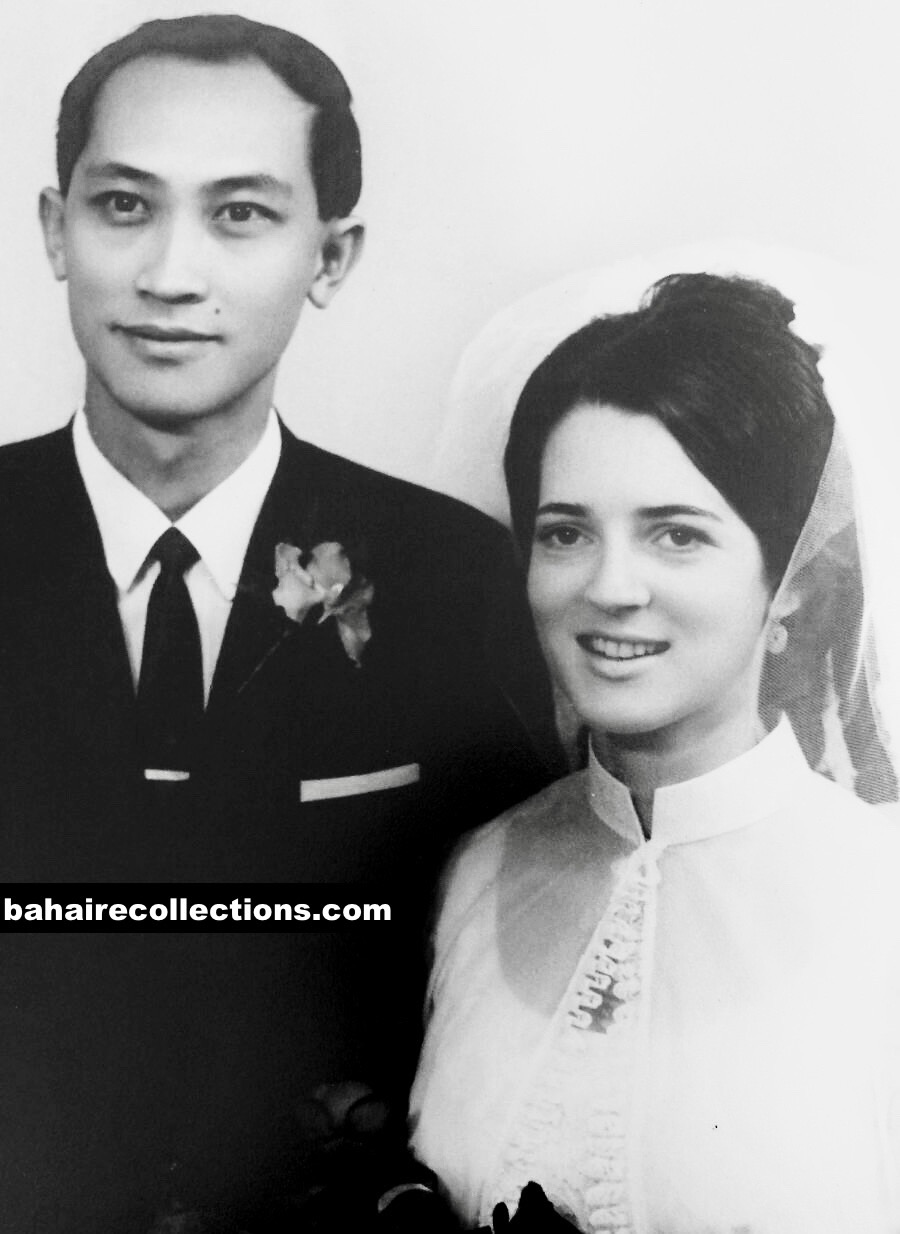
Ho San and Mariette’s wedding photo, 1969.
The respect Ho San had for Mr. Featherstone was very overwhelming. He was always conscious of the fact that his father-in-law was none other than a Hand of the Cause of God, appointed by the Guardian of the Faith. When Mr. Featherstone passed away in Nepal on 29 September 1990, Ho San found it difficult to come to terms with his untimely passing. At the fiftieth anniversary of the acceptance of the Faith by Yankee Leong held in Ipoh town, Malaysia in December 2003, Ho San was addressing the gathering and he touched on Mr. Featherstone. When he mentioned that name, he sobbed and took some time to compose himself. The gathering of some two thousand believers observed what the Hand of the Cause meant to Ho San.
MARRIED LIFE
In December 1971, Ho San and Mariette set sail for Australia and settled in Sydney. It was in October 1972 that Ho San’s illustrious father Leong Tat Chee passed away in Malacca. Leong Ho Chiew sent a cable to Ho San with the news. Mariette and Ho San were deeply saddened that they could not return for the funeral. But they went to the House of Worship in Sydney to offer their prayers.
It was while in Sydney that their first daughter Mei-Ling was born in early 1973. They brought up this precious child in a two-bedroom apartment located close to the Bahá’í House of Worship. They would visit the Bahá’í House of Worship often for the normal Sunday morning service. Mariette joined the Temple choir and sometimes both would be called upon to read from various holy scriptures at the service. Ho San was the Chairman of the National Persian Affairs Committee. This was a time when the Persian believers were beginning to arrive in Australia and they required assistance to assimilate into the Bahá’í community. Mariette and Ho San chose to live in Campsie as that was a goal area at the time and they endeavoured to establish a Local Spiritual Assembly there which was achieved in 1973.
PIONEERING
It was at this time that they saw an appeal from Papua New Guinea in the Australian Bahá’í Bulletin for caretakers at their national office and property in Lae. They offered their services and on 8 May 1974 left for that country. When they arrived at Lae airport, to their surprise, they were met and welcomed by Hand of the Cause of God Collis Featherstone and Knight of Bahá’u’lláh Violette Hoehnke. In Papua New Guinea, Ho San and his wife ended up not as caretakers but instead Ho San took up a data processing officer position at the Papua New Guinea University of Technology Lae.
They pioneered in Papua New Guinea for 20 years spanning over a period of 26 years. It was a time when two of their four children were born in Lae. They also adopted Seff Homerang, the year after their arrival, who is from Madina village in New Ireland. Ho San and Mariette served on the National Spiritual Assembly of Papua New Guinea and had the privilege of attending, as delegates, the 1978 International Convention in Haifa, to take part in the election of the Universal House of Justice.

Ho San and Mariette with daughters Mei Ling and Su Yin, in Lae.

Sogeri, Papua New Guinea in 1974. Ho San is far right.

Papua New Guinea Independence parade in Lae on 16 September 1975. Ho San stands to the extreme left.
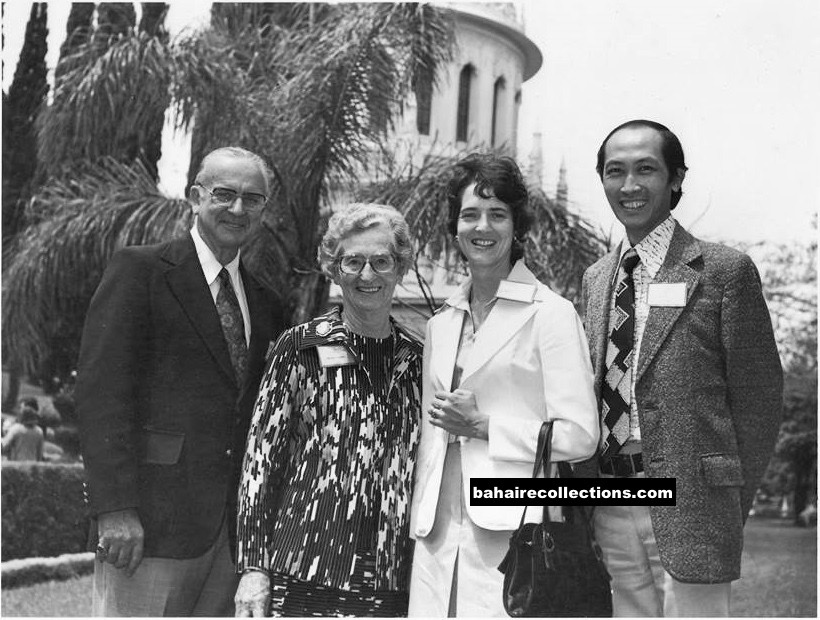
Leong Ho San and Mariette with Hand of the Cause of God Mr. Featherstone and Mrs. Featherstone at the Shrine of the Báb during the International Convention in May 1978.
One of the highlights of his pioneering in Papua New Guinea was a very special the arrival of Hand of the Cause of God Amatu’l-Bahá Rúḥíyyih Khánum, accompanied by Mrs. Violette Nakhjavani in 1984. The believers were simply overjoyed and made every effort to meet her. Rúḥíyyih Khánum went to several village areas around the country and inspired the local friends with her stories of the Guardian and her travels around the world, talking about the fundamental teachings and explaining what it meant to be a believer in this wonderful day, no matter who and what we were.
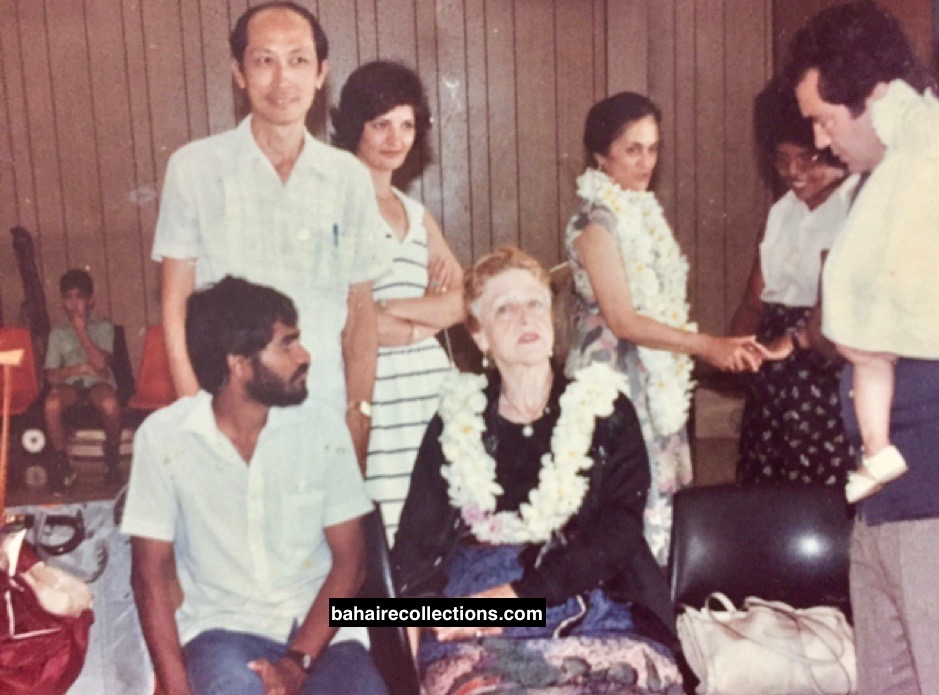
Amatu’l-Bahá seated with Ramu Sanyasi, another Malaysian pioneer on her visit to Papua New Guinea. Standing at left is Ho San. Third from left is Mrs. Violette Nakhjavani.
Ho San also recalls meeting Amatu’l-Bahá Rúḥíyyih Khánum at the World Centre in the 1990s. He writes, “We saw her again on two other occasions in the 1990s at the Bahá’í World Centre when two of our daughters were serving there. The first was when she graciously invited us to have afternoon tea in her home and gave us a tour of her famous museum of artefacts collected from her travels around the world. The second and final meeting with her, several years later, was getting an invitation to have dinner with her and other guests. She sat me on her right and kept piling my plate with food on that unforgettable night! She was truly an amazing person, and she lives on in our hearts today!”
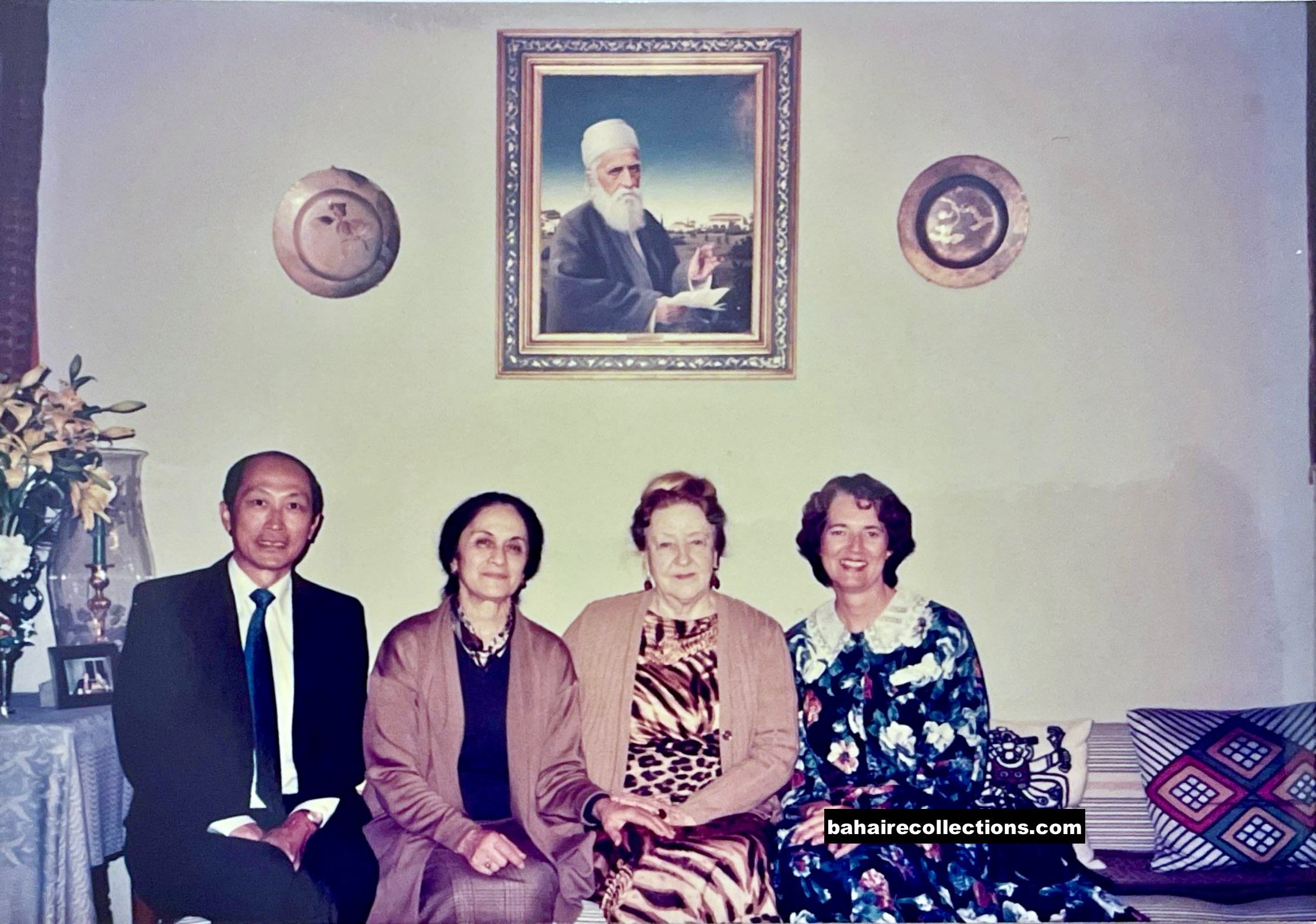
At the Holy Land in 1992. L-R: Ho San, Violette Nakhjavani, Amatu’l-Bahá and Mariette.
Ho San was appointed an Auxiliary Board member from 1978 until 1981. During that time he had many experiences of visiting the villages in Goroka and Hagen. He was also a member of the Pioneer Committee with Mariette and others, and they assisted in the pioneering needs in Papua New Guinea and overseas.
In 1981, the couple left Lae and returned to Australia settling in Camden, New South Wales, as this was a goal area. They assisted in forming the first Local Assembly there in 1983.
BACK TO PAPUA NEW GUINEA
They returned to Papua New Guinea in 1984 but this time to Port Moresby and spent four years where Ho San worked with the National Housing Commission. In Port Moresby, Ho San was Treasurer of the Local Assembly for more than five years.
Another unforgettable occasion was in 1985 when the book ‘The Promise of World Peace’ was launched worldwide by the Universal House of Justice. Ho San and Mariette had the task of presenting the special edition of this book to the Governor General of Papua New Guinea at an afternoon tea reception.
 One of the several visits by Hand of the Cause of God Mr. Featherstone and Mrs. Featherstone to the family of Ho San in Papua New Guinea in the 1980s.
One of the several visits by Hand of the Cause of God Mr. Featherstone and Mrs. Featherstone to the family of Ho San in Papua New Guinea in the 1980s.
At the end of 1988, they left when Ho San’s contract expired and went back to Camden until 1992 when they returned to Port Moresby again as Ho San obtained a contract with the Department of Works.
The most stirring experience of their time in Papua New Guinea was the Holy Year of 1992 when the Most Holy Book, the Kitáb-i-Aqdas, was released worldwide. When the local friends heard of this they were simply ecstatic that they would have this special book. Some villages built a special home for it – Haus Tambaran, or Spirit House – and on the day when the book was delivered in person, they marked the occasion with a great celebration and feasting to honour its reception. The believers were illiterate, by and large, but that did not deter them from showing their utmost reverence and love for the gift of the Kitáb-i-Aqdas in their lives!
In January 1993 in Madina village, the Bahá’ís held a very auspicious traditional ceremony to mark the Holy Year. One of the chiefs gave a talk about flying foxes that fly in the night and eat off the fruits of trees. After feasting on the fruits, the flying foxes all leave and fly far away. In doing this they scatter the seeds of these fruits to new regions, and in time they sprout into trees and bear new fruit.
TRIP TO CHINA
In mid-1994 Mariette and Ho San, together with Su-Yin, Kim and Fei-Lee went on a teaching project to China, in response to a call by the House of Justice to visit countries in Asia and the Pacific. They travelled to China at the request of the National Spiritual Assembly of Papua New Guinea, as it was a great opportunity to visit the land of Ho San’s ancestors. Mariette had a very interesting dream on the train from Beijing on the way to a small city when her father appeared to her. He assured her that the teaching would be a success and not to worry, everything would fall into place for openly sharing the teachings with the friends. And it all certainly did. At the teachers’ college they visited they were welcomed with open arms and in the classroom they shared the basic teachings on the unity of God, the unity of all the religions of God, and the unity of mankind! The college principal and staff hosted a sumptuous lunch in their honour.
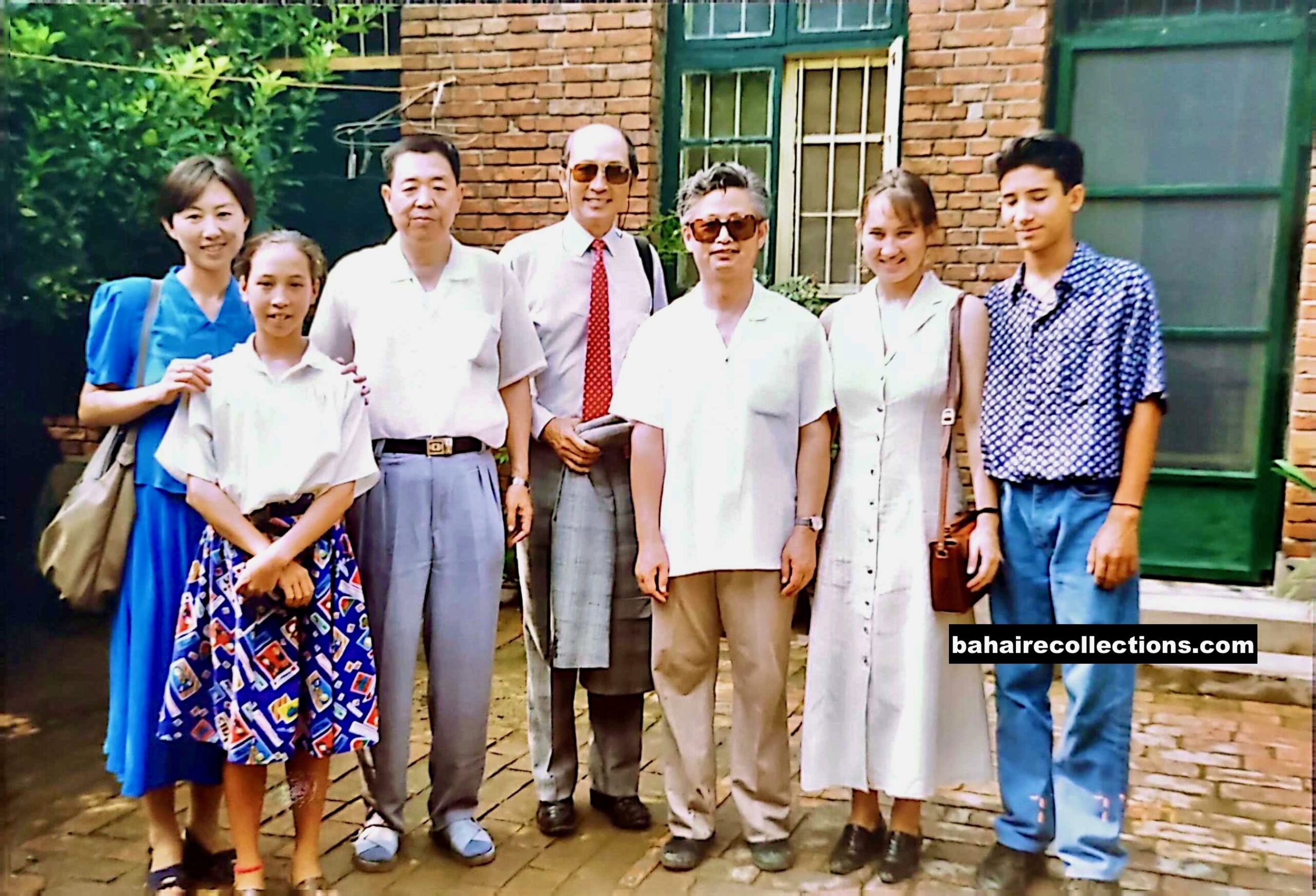
Visit to a University in Shanghai in 1994.
TO SOUTH KOREA
And in October 1999, again in response to the National Spiritual Assembly of Papua New Guinea Ho San made a 2-week visit to South Korea and managed to meet with their National Spiritual Assembly for dinner on the first day of arrival in Seoul. They asked him to attend a weekend conference, to meet with the local friends and share teaching stories and how his family, from a Taoist Confucian background – the main religion of the Koreans – learned about the Bahá’í Faith in the Ten Year Crusade and accepted the teachings of unity in diversity.
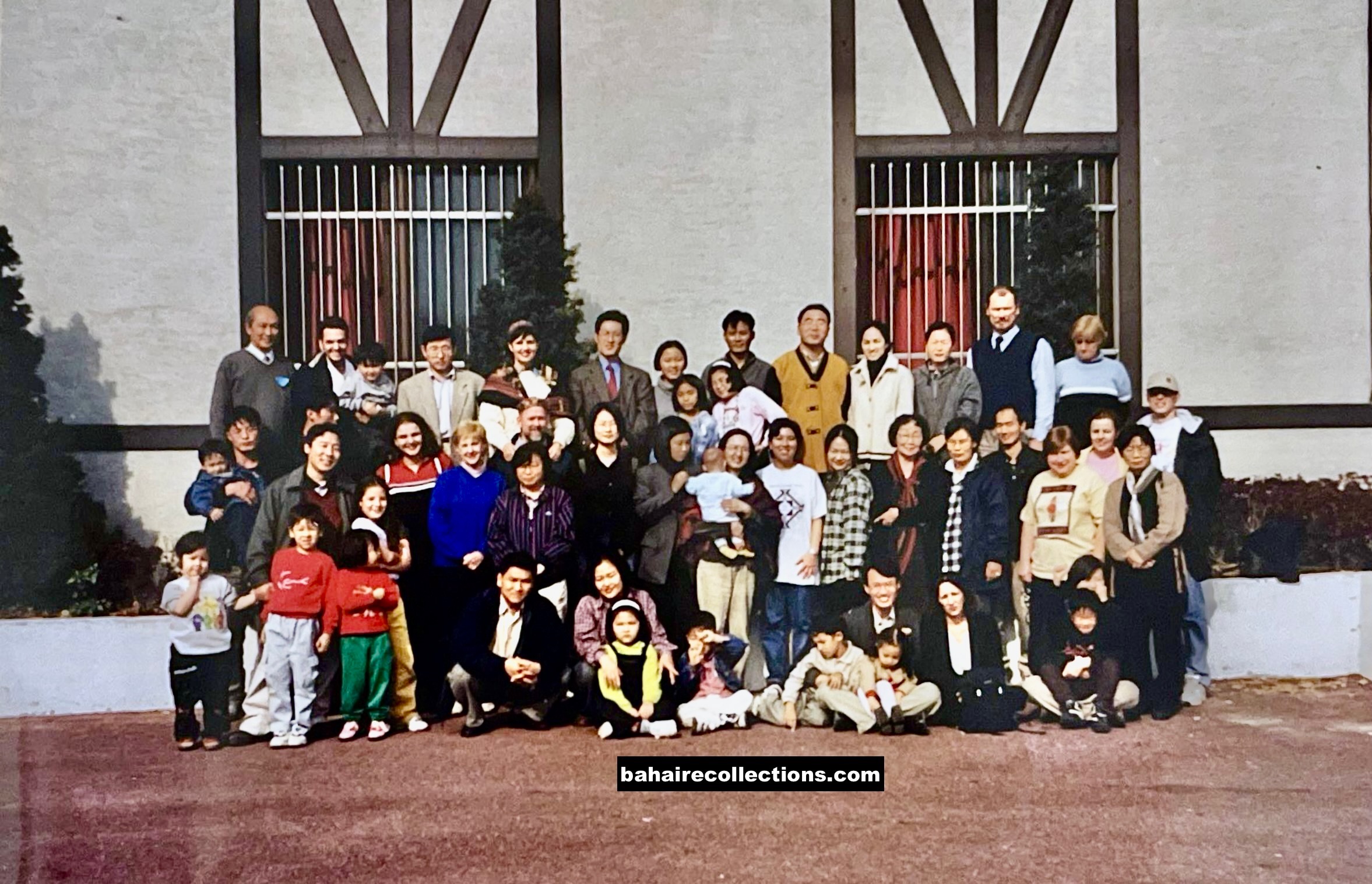
Ho San is top left in the group photo of the conference he attended in South Korea.
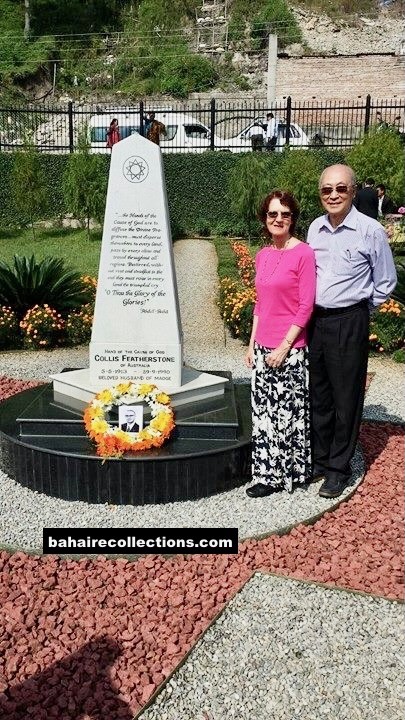
The couple at the resting place of Mr. Featherstone in Kathmandu, Nepal.
RETURNED TO AUSTRALIA
Ho San and his family returned from Papua New Guinea to Australia in December 2000. They settled in Sydney and later moved south to Wollongong. While in Sydney Ho San was a regular participant at prayers held at the House of Worship on Sundays, after which he used to gather with his friends for some refreshment or meals.
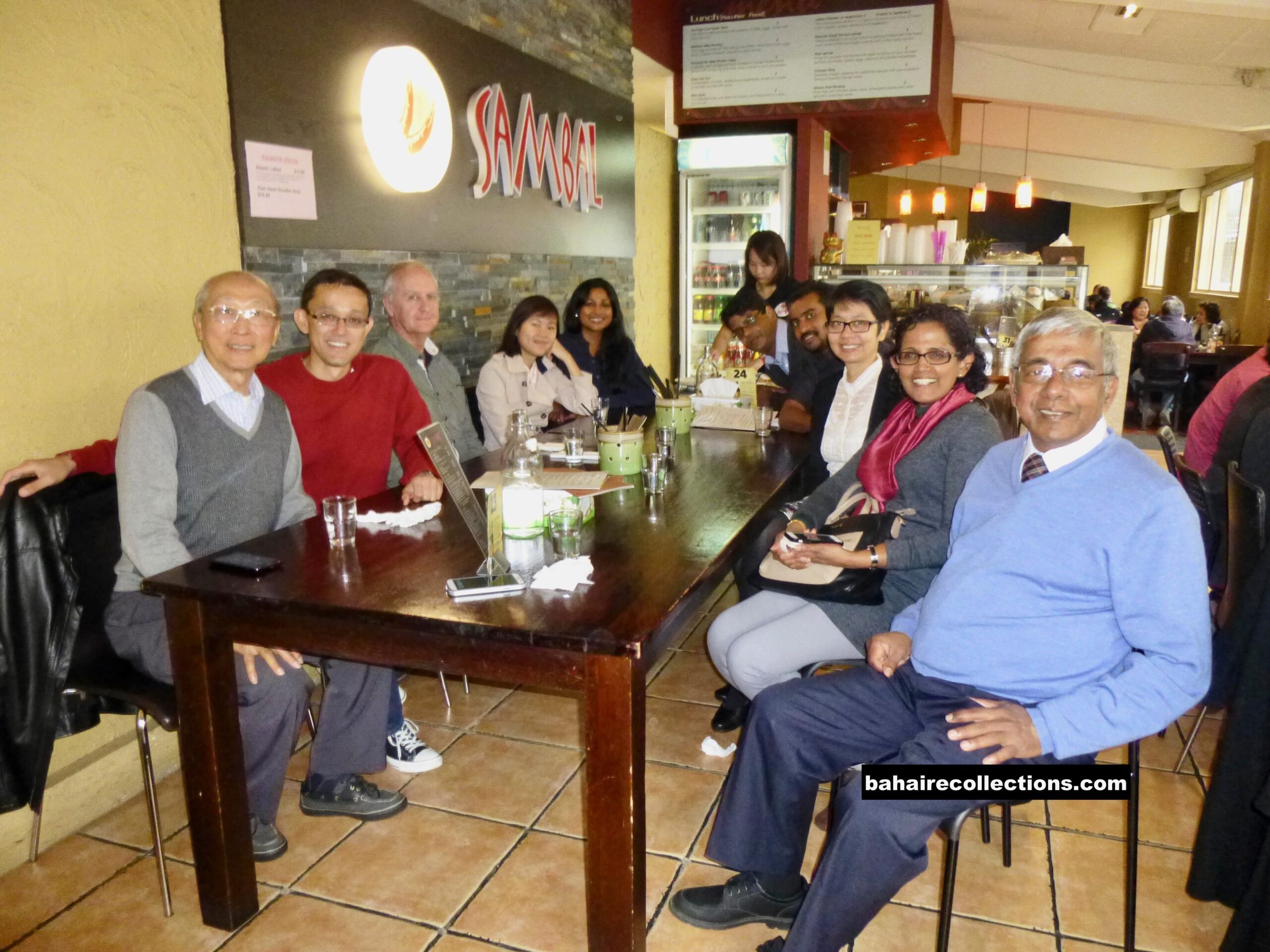
One of those gatherings of friends in a restaurant after prayers in the House of Worship in Sydney. Ho San is at left and N.S.S. Silan on right, with Usha Cheryan next to Silan.
Ho San and Mariette were true lovers of humanity. They considered everyone who crossed their path as their own family members. Their home in Wollongong was a refuge and sanctuary for many friends and visitors alike.
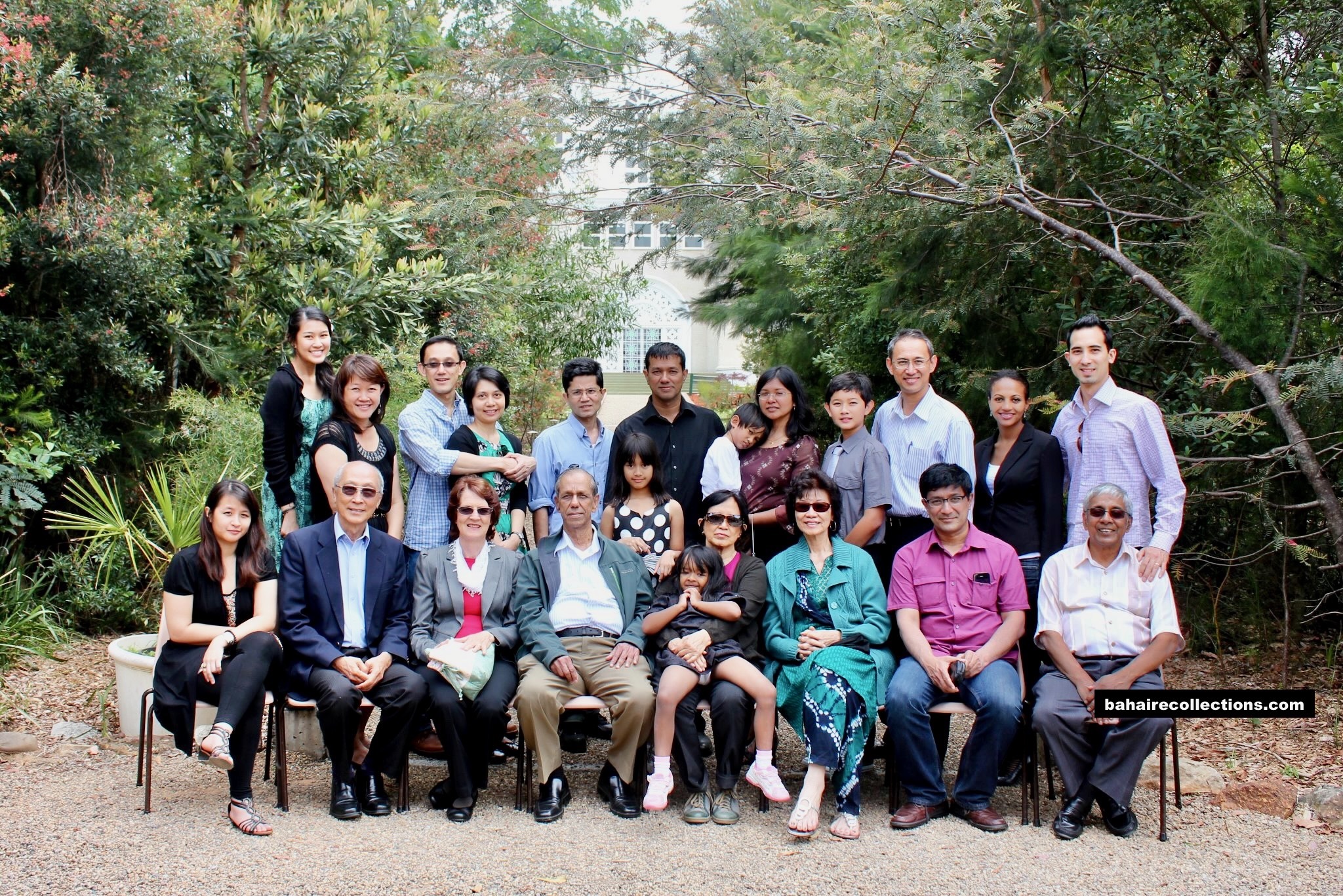
A family gathering at the Bahá’í House of Worship in Sydney in 2011. Ho San’s sister Mary is seated in the centre with a child on her lap. Mary’s husband Dharmalingam is seated fourth from left. Their children and their spouses and children are standing at the back row. Seated at the extreme right is N. S. S. Silan, a close friend of the Leongs.
Ho San and Mariette made several trips to Malaysia throughout their stay in Australia to visit friends, relatives and to participate in Bahá’í activities.
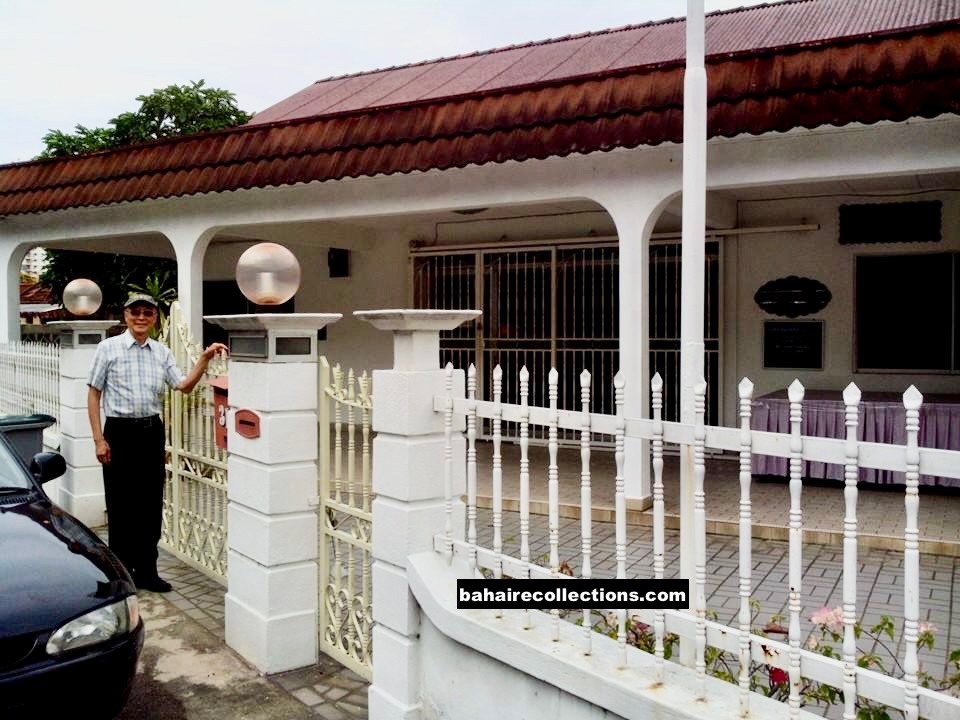
In August 2014 Ho San visited his former house, now a Baháʼí Centre in Malacca. The family donated this property as endowment to the National Spiritual Assembly of Malaysia in 1967.
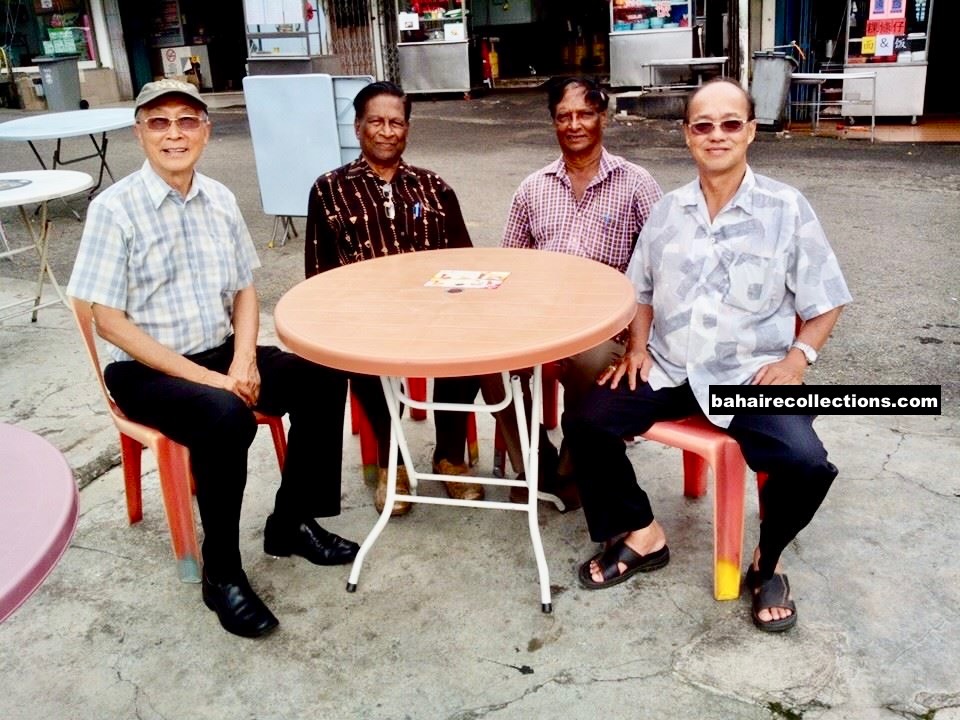
Ho San at left, meeting up with old friends in Malacca, August 2014. To the left of Ho San are Kumara Das, S.K. Somu and Jeffery Cheong.
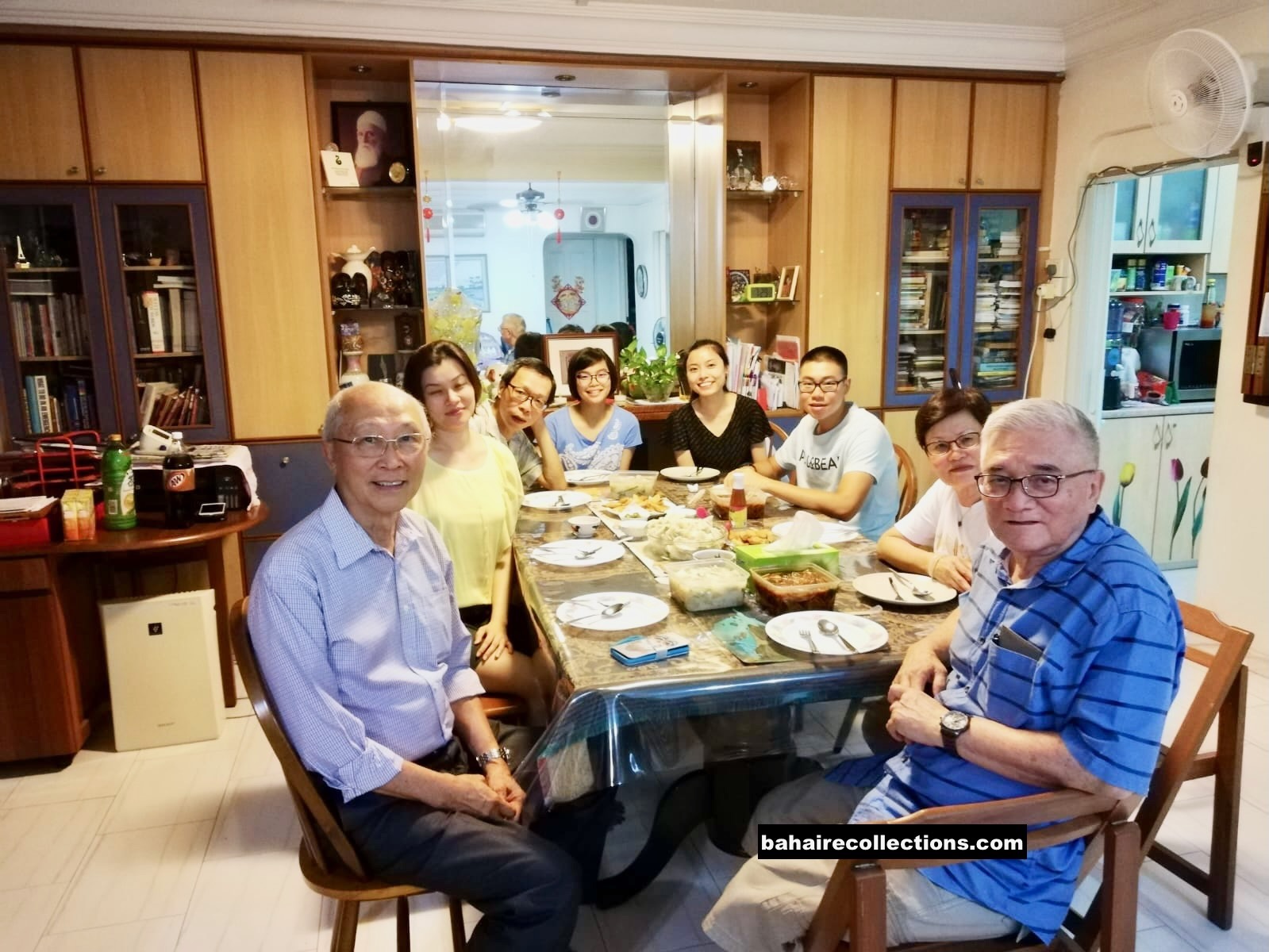
Ho San visits the family of Yin Hong Shuen at the latter’s apartment in Singapore, February 2019.
The couple spent the later part of their time looking after their grandchildren and at the same time opening their home to believers for activities. Theirs was a home that abounded in warm hospitality. Ho San was always conscious that life on this earthly plane was of a fleeting moment. He found every opportunity to serve his Lord in whatever way he could.
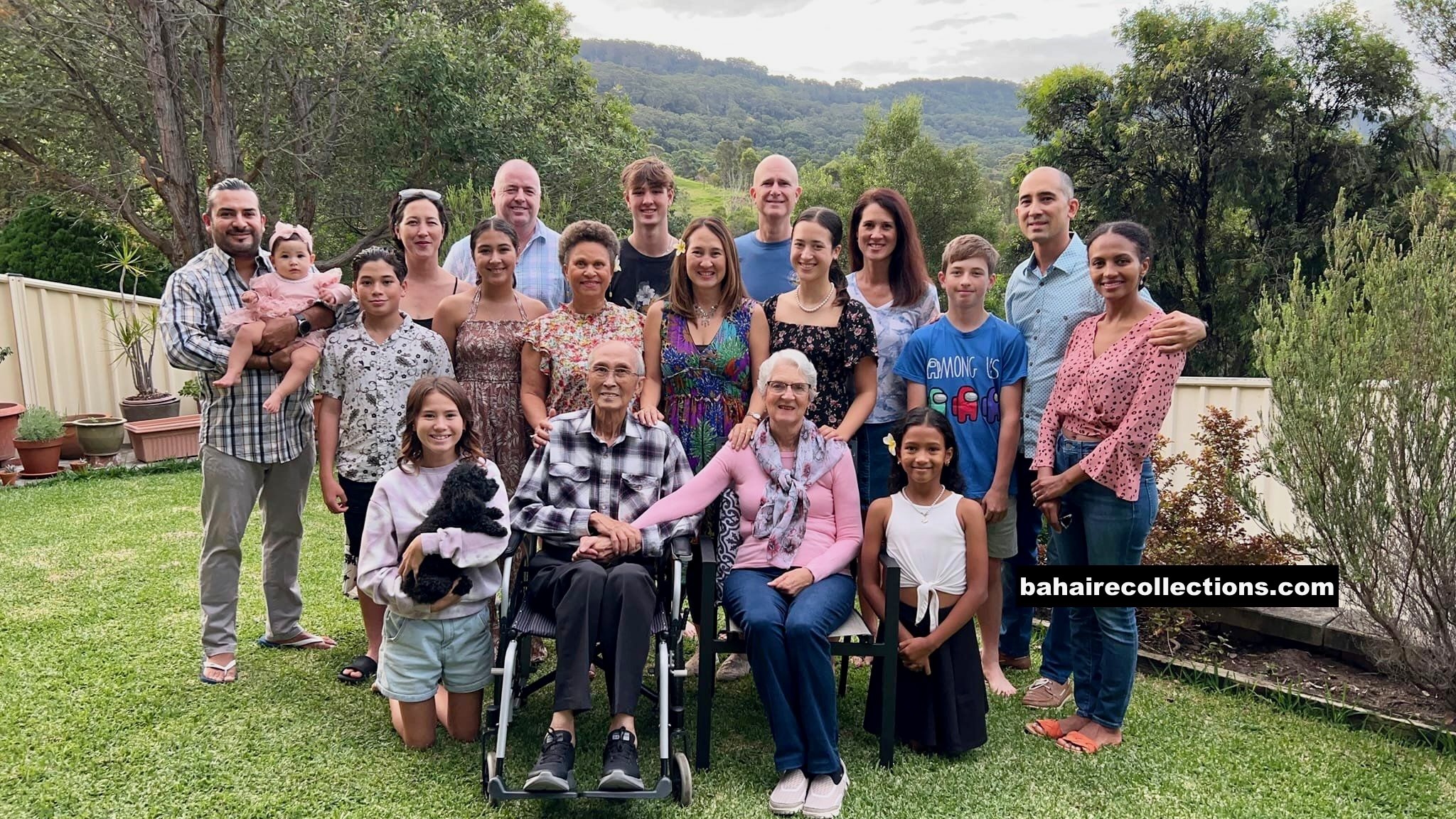 The last family photo taken just four days before the passing of Ho San.
The last family photo taken just four days before the passing of Ho San.
Ho San aged gracefully and spent his time reading the Writings and participating in Baháʼí activities within his community. He developed some hearing impairment but kept communicating with friends over WhatsApp and emails. Towards the last few years, he developed some ailments. Though his physical self was weak and frail, he demonstrated a firm fighting spirit and resorted to prayers. He was well prepared to be called by His Creator. Three days before passing he sent a message to a believer who was serving as a volunteer at the Baháʼí House of Worship in India. The message read, “Please pray for a smooth transition to the next world”. Then came the news that his precious soul had taken its flight to the Abhá Kingdom on 10 April 2023 to be with His Lord and in the company of those angelic souls that had ascended before him. He was laid to rest at the Lakeside Memorial Park, Dapto, New South Wales, Australia, following a befitting memorial service.
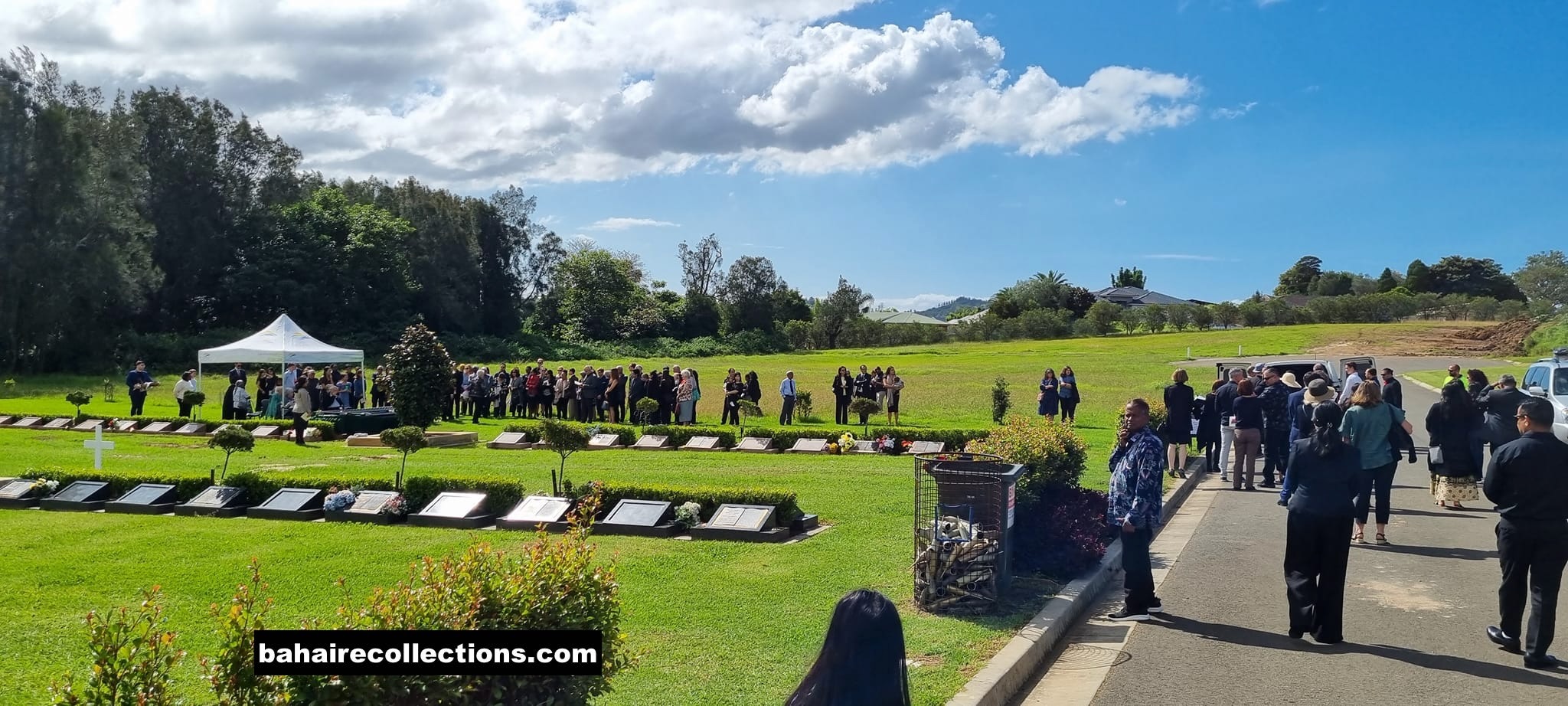 Lakeside Memorial Park, Dapto where Ho San is laid to rest.
Lakeside Memorial Park, Dapto where Ho San is laid to rest.
IRREPARABLE LOSS
In his passing the community of the Greatest Name has lost one of the best gems created by the wondrous hands of Baháʼu’lláh. We can only say farewell to a true soldier of Bahá’u’lláh, who has left traces that will continue to decorate the pages of history. His warm smile and his friendly face will be missed and fondly remembered. Looking at the life of this star-servant of the Cause one is tempted to mention that in so many ways, the pure-hearted Ho San has touched many hearts through the life that was well lived as a true Baháʼí. It is our ardent hope and prayer that Baháʼu’lláh may reward Ho San his full share of divine blessings for his labours in this world, performed with so much commitment, zeal and sincerity.

Graveside of Leong Ho San
A. Manisegaran
31 May 2023
Copyright@bahairecollections.com
You may leave your comments at: info@bahairecollections.com
22 thoughts on “REMEMBERING LEONG HO SAN”
Dear Mr. Manisegaran,
I vividly recall expressing earlier in this blog the immense privilege it is to delve into the remarkable Leong family’s story. Immersed in the extraordinary reminiscences of Mr. Leong Ho San, one is reaffirmed in witnessing the pinnacle of dedication, love, zeal, and unwavering faith that position him as one of the most exceptional exemplars, a shining servant-star, and a precious gem fashioned by the wondrous hands of Baháʼu’lláh. Leong Tat Chee – Leong Ho San: Like father, like son! Indeed, as the saying goes, “A tiger cub will never become a kitten.” With over six decades of outstanding and unparalleled service to the Cause, his contributions are nothing short of extraordinary. And you have diligently unearthed every single detail with meticulous care and precision. Your commitment to the task is truly commendable, and the results speak volumes. Exceptional work, indeed!
In the Light of Guidance, p. 578, the beloved Guardian confirms the following profound insights:
“The Guardian is acutely aware of the tremendous sacrifices demanded of devoted pioneers and the challenges they must confront and overcome. Thus, he holds that pioneering work stands as the most crucial Bahá’í endeavor an individual can undertake today—more significant even than serving on a National Assembly or any administrative post. While it entails immense responsibilities and difficulties, its spiritual blessings are of such magnitude that they overshadow all else. The opportunities for special victories for the Faith are abundant, and the soul that once savors the elixir of pioneering service seldom desires anything else.”
He further proclaims in The Compilation of Compilations, vol II, p. 222, “Once a few bold and self-sacrificing individuals arise to serve, their exemplary actions will undoubtedly inspire other timid souls, aspiring pioneers, to tread in their footsteps. The annals of our Faith are replete with accounts of remarkable achievements accomplished by seemingly ordinary and insignificant individuals who, by placing their trust in God and rising to proclaim His Message, became beacons of light and pillars of strength.”
In alignment with the author’s sentiments, I join hands in expressing our fervent hope and prayer that Baháʼu’lláh, the Manifestation of God, may shower Mr. Leong with his full measure of divine blessings for his labor in this world—efforts performed with utmost dedication, fervor, and sincerity.
Baháʼu’lláh Himself bears witness:
“Those who forsake their homeland in the path of God and subsequently ascend unto His presence shall be blessed by the Concourse on High. Their names shall be inscribed by the Pen of Glory among those who have sacrificed their lives as martyrs in the path of God, the Helper in Peril, the Self-Subsistent.” [Messages from the Universal House of Justice 1968-1973, page 102].
With loving Bahá’í greetings,
Vela Gopal
Phnom Penh
Cambodia
Dear Mr. Manisegaran
This is a well- written story of a Baha’i who served the Cause of his Lord to the end of his life on this physical world. His life shall always be an example to emulate.
I have met this wonderful soul once a few years back at a gathering which I am unable to recall where. However I recall asking him if he was Leong Ho Chiew’s brother due to his striking resemblance to him. He acknowledged with a warm smile.
I read with interest his early teaching days among the aboriginal friends in Kampong Chang and he befriending Deroah who was the only indigenous representative of the then Malayan community at the First Bahai World Congress in London in 1963. The children of the late Deroah are very active in the Faith and one of them is the first Counselor from the indigenous people of Malaysia. The seed that Deraoh had sowed has well fruited today.
I was also in Port Moresby in Papua New Guinea, when I spoke to the local older Baha’is. They recall with fondness all the beloved pioneers from Malaysia including Ho San.
Thank you for giving us this glimpse of Uncle Ho San, he served the Cause of Baha’u’llah with distinction like his illustrious father, beloved Leong Tat Chee. And we can also never forget his strict disciplinarian brother, beloved Leong Ho Chiew, who also served this Faith with distinction. And the entire family of Leong Tat Chee are still actively serving this Cause wherever they reside.
My prayers are that that God grant bountiful favours on this wonderful and loyal servant of the Cause. Reading the story I can see that he was one of the greatest soldiers of Bahaullah who is sure to be richly blessed in the world hereafter.
Vijay Saravanen
Subang Jaya
Selangor
Malaysia
Hi Mani
Thank you for sharing the very interesting and informative biography of Ho-San Leong. We were in the same Baha’i community in Lae, Papua New Guinea in the 1970s. Mariette and Ho-San’s love for each other, their family and the community was sincere and generous.
Dianne Bluett Wellington-Miller
Malanda,
Queensland
Australia
Dear Mani,
I just finished reading your story on Leong Ho San. Such an awe inspiring, moving story of a servant of Baha’u’llah fired with the love of God and serving the Faith unrelenting and with full zeal. I have the greatest respect for his father Mr. Leong Tat Chee. Even though I did not meet his father in person I went to his graveside in Malacca and prayed and sought his spiritual assistance to serve the Faith. I have met his sister Mary in Ipoh during my teaching work. I also met his sister Lily Chinniah many times. When I was doing my housemanship in Johor in 1975 his younger brother Leong Ho Min was staying in the Bahai Center with me. Each family member has served the Cause well.
Leong Ho San’ s dynamic force of example brought many people into the Faith. You have done a historical work in writing the life and times of one of the greatest early believers of Bahai Faith in Malaysia. Great job Mani. God Bless you always.
Professor Dr. Ananthan Krishnan
Puchong
Selangor
Malaysia
The story of Leong Ho San with all those lovely photos have brought him to life. From the story it is clear that Ho San has done so much for the Faith.
Ho San was about my age and meeting him for the first time became a long lasting friendship. I remember when Ho San was back from the United Kingdom in 1968 I was invited to their home in Malacca to attend a fireside. I was asked to say a few words on the topic that was being discussed and Ho San translated it eloquently into Chinese. We met again on numerous occasions and shared on the progress of the Faith. The last time we met was at the House of Worship in Sydney and had lunch in the temple’s gardens.
Ho San in my estimation was a loving, thoughtful, and humble person. His sweet smile and radiant his face touched the heart of those who came into contact with him. It is difficult to believe he is no more with us.
He belongs to the Ten Year Crusade period. And with his passing the early batch of those who belonged to that historic period is being reduced. He was one of those last living believers of that period. I am happy his contribution and services to the Faith are well recorded for the whole world to read.
God bless his radiant soul.
Dr. Firaydun Mithaq
Chieng Mai
Thailand
Thank you Manisegaran for writing on the services of Leong Ho San who accepted the Faith in Malacca around the same time as me. I had known his early life in Malacca but not after he had migrated to Australia following his marriage. Now that you have written the later part of his life, I am able to put the pieces together and can see with clarity that Ho San was meant for greater things for the Cause. I remember the Sunday classes that he attended with many other youths who all rose to serve the Cause with distinction. His illustrious father Leong Tat Chee had always wanted to pioneer, and did carry out some teaching activities in Taiwan, Hong Kong and Macau. Likewise Ho San had done the same by pioneering to Papua New Guinea. I agree with your statement that Leong Tat Chee was Ho San’s spiritual father as well.
He was very active and in the forefront of activities in Malacca. He had read the writings widely and had a good understanding of the Cause. I can see from your story that throughout his life Ho San had tried to please the heart of the Blessed Beauty through his services for the Cause. He is one that the current generation can emulate, as he has set an example in his own way.
Ho San loved Malacca and Malaysia as this is where his early friends were. And on many of his visits I was fortunate to have renewed my connection with him. I too miss him. But I am sure he is happy where he has ascended now, for all the services he had done for the Cause he is sure to be rewarded by his Creator.
Thank you Mani for one more story that stirred my heart
Anthony Casimir Louis
Malacca
Malaysia
Dear Mani,
I knew Leong Ho San briefly as he had left the country long ago. But your story has it all. Reading the story I wonder what a privilege he had to meet some Hands of the Cause, attend the first Baha’i World Congress in London in 1963 and go to Bab’s residence in Shiraz, and above all his pioneering days in Papua New Guinea with his dear wife Mariette, where they started to build their family. His entire life after accepting the Faith in 1957 has been spent in serving the Cause.
Thanks for the write-up Mani.
Wong Meng Fook
Singapore
Thank you Mr. Manisegaran for sharing the inspiring story of our dear Baha’i brother Mr. Leong Ho San, who had served the Cause of Baha’u’llah with such great love, dedication, and consistency. Malacca seems to be the place where the Faith first bloomed and it’s fragrances spread to other parts of the country including the Aboriginal community (Asli).
As early as 1962, Ho San has offered the precious teachings of Baha’u’llah to the Asli community. He had also pioneered to Papua New Guinea for more than 20 years. I also read with great interest that he is a son of Mr. Leong Tat Chee. Mr. Leong Tat Chee is one of the early believers and a great personage of the Malaysian Baha’i Community, the like of Uncle Yankee Leong, Dr. Chellie Sundram, Uncle Nagaratnam and others. Assuredly, the blessing of Baha’u’llah are upon them.
Selvam Ellumalai
Johor Baru
Malaysia
dear Mani,
I was not aware tha Ho San had passed away. It was through this story of yours that I came to know that this dear friend had passed away.
Yet it was heartwarming to read his life story. He was indeed a very special man, as evidenced by what has been written about him.
I had the privilege of meeting him and Mariette many times over the years.
May Ho San’s soul soar in Abha Kingdom.
Many thanks,
Fahimeh Walker
Sydney
Australia
“To please the heart of the Blessed Beauty” . What a beautiful motto that our dear Ho San had! I was amazed at his wonderful life of dedicated adventures as a youth to even after he was married with children.
His smiling disposition reminds me of his father Uncle Leong Tat Chee who towers as one of the earliest pathfinders and pillars of the Faith. The story of Ho San and his dear wife Marriette will warm the hearts of many of us who are or have been ourselves striving to serve at various outposts like Papua New Guinea or the aborigine villages and rural parts of the world.
I met Ho San only on a few occasions and was very impressed by his sense of humor, intellect, humility and his ability to engage with people of all levels of society, from villagers to Governors. One would have wished to have known him better especially on how he was able to focus on family, work and service for the Cause in such a coherent and successful way.
On reflection, I feel like a midget compared to this giant and pray that I too like Ho San, will walk “steadfastly in His love, until his soul hath winged its flight unto God, the Sovereign Lord of all, the Most Powerful, the Ever-Forgiving, the All-Merciful.” Gleanings from the Writings of Baha’u’llah – LXXXVI – (p. 86 para 2)
Yin Hong Shuen
Singapore
Dear Mani,
Just read your write-up on our dear Leong Ho San. That was a fantastic narration with lots of inspiration. Photos too speak volumes. I knew Ho San in person, and I also knew the many other names mentioned in the story.
Ho San has done so much for the Cause. I must admit in all humility and honesty that I feel very small and insignificant when I compare myself with all those giant souls of yesteryears. I can only say maybe I am one percent of these great personalities. Ho San, like his father Uncle Leong Tat Chee has indeed decorated the pages of our glorious Faith through services that can never be erased. It is equally remarkable that he and his beloved wife Mariette teamed up so perfectly to serve the Cause, and bring up their children in the Cause.
Mani, once again many thanks for such a great write up,
Chong Boo Haw
Alor Star
Kedah
Malaysia
Dear Mr. Manisegaran,
Thank you for the wonderful write up on Leong Ho San. It was so moving to my heart. I was also moved by the many photos are so significant.
Leong Ho San is one whom I did not meet in person. But the story has brought him back to life. It was like meeting him inn person. He is one of those gifted believers to have met so many Hands of the Cause, attended the First World Congress in London and also went to the House of the Bab in Shiraz. And he was also one of the only few to have passed two nights in the Mansion of Bahji in Akka. A wave of emotions ran over me to read all these accounts. Not all of us are gifted with such blessings. And I was pleased to learn that he and his wife pioneered as well- to Papua New Guinea where they created impacts as well.
And the part that touched me was his wish to have a smooth transition to the next world. And his prayers were well answered.
The story was so moving that I read it twice, and I shall continue to read as many times as I can. It is people like Leong Ho San whom the younger generation has to look upon to emulate. This story should reach all the younger people, for they are sure to be touched by such stories. He occupies a special place in our history.
A personal thanks to you for this wonderful story. Please continue providing such stories in abundance.
Mrs. N. Kasthuribai
Chennai
Tamilnadu
India
I really appreciated reading your article about dear Ho-San, and filling in many of the biographical details of his illustrious life.
I think you were very thorough. I was very touched by how assiduously Ho San maintained contact with friends around the world through social media and email. He was an excellent communicator and kept in touch with me often as my late father was passing. They were both so devoted to the Cause, and Ho-San generous in his acknowledgments of my father’s services. I like to think that they may now have met, in the world to come.
Heather Cardin
Quebec
Canada
Dear Mani
The news of the passing of Leong Ho San made me feel really sad. I finished reading the entire account and was really moved by his early propensity for the Baha’i faith. His devoted affection and selfless service for the glorious Cause of Baha’u’llah will serve as an example for the current generation and generations to come. Thank you very much Mani, for providing us such an account of the life and legacy of Leong Ho San.
I recall first seeing him and his wife Mariette in Kathmandu at Mr. Collins Featherstone’s burial and then again at a dinner held by the Baha’is in Sydney during my brief visit there.
My sincere condolences to the grieving family and best wishes for his soul to continue to journey in the worlds beyond.
Warm regards,
Narendra Pande
Dhumbarahi
Kathmandu
Nepal
Dear Mani
I am most grateful to read yet another true life account of a valiant soldier of the Ten-Year Crusade period. Leong Ho San was indeed a champion-servant of the Cause of Baha’u’llah.
Reading your impeccable story on the life of Leong Ho San, I realize that his lifetime of dedicated service to the Faith was quite different from the other homegrown heroes and heroines of his time. His early and youthful service locally was of high standard matching the great deeds of many of his contemporaries as recorded in your earlier series of recollections. Beyond that, his chosen spiritual battlegrounds were largely overseas, and he had done a splendid job at that.
His bountiful blessings of meeting so many of the Hands of the Cause of God would be an envy of any ardent follower of Baha’u’llah.
His amazing and rewarding journey in the service to the Cause would guide and inspire generations to come.
May Ho San’s soul be richly rewarded in the Abha- Kingdom.
Keng Tong Hua
Skudai
Johor
Malaysia
Dear Mani
I read with the greatest interest your comprehensive write up on Leong Ho San. I had met Ho San briefly in Malacca when he came back from the United Kingdom , and later when I was working in the national Bahai office as Administrative Assistant, I had met him and his wife in the home of Inbum Chinniah who the secretary of the National Spiritual Assembly and the brother-in-law of Ho San. At that time, I observed him to be a soft spoken and a shy person. But I did not know much of his later life until I read your story. And your story has unearthed so much information which was hitherto unknown to me. His involvement in activities in Malacca, his early Asli teaching, his days in the United Kingdom, his pilgrimage to the House of the Bab, his stay in the Mansion of Bahji his close association with so many Hands of the Cause, and later his pioneering to Papua New Guinea and his continuous service till his last days in Australia are matters not known to me. What I can see is that Ho San was one who served quietly and without seeking publicity. And his was blessed with a very supportive wife. They had teamed up so well.
We are slowly being robbed of the great heroes of those days who had enriched the history of the Faith. This is one story that has truly inspired me so much.
Thank you Mani
C. Kanagaratnam
Arizona
USA
Dear Mr. Manisegaran,
I read your story on Leong Ho San, and found it to be one of the greatest stories that you have brought to the eyes of the readers across the globe. It was a spiritual treat for me. I am sure I am echoing the sentiments of other readers as well. It was so touching and kindled my heart!
The story itself and the photos published have given life to Leong Ho San.
I have learned so many things bout Leong Ho San whom I had never met. I have read about him here and there in the other stories published in the blog, but they were merely passing statements. For the first time I am able to get a very clear picture of Leong Ho San in this story. He is surely a chosen one to serve our beloved Faith at a time when the Faith was emerging from obscurity, especially during the Ten-Year Crusade period. And he has continued his services for the Cause till the end of his life.
Leong Ho San has had several blessings which we can never dream of, especially passing two nights in the Mansion of Bahji. I was really emotional when reading this-had goose bumps as they say! And going to the House of the Bab at a time when it was still possible. His close association with many Hands of the Cause of God is something that we current generation of Bahais and Bahais of the future could never dream of, as the appointment of the Hands has ceased after the passing of our Guardian. I can also see that he has been blessed with a wonderful wife who stood by him from the time he married her, as well as a wonderful family the couple brought up.
Thank you for once again publishing one more beautiful story.
Jaya Raju Thota
Greater Visakhapatnam
Andhra Pradesh
INDIA
I first met Leong Ho San in Petaling Jaya in 1968 and later in Papua New Guinea in 1978, and then in Australia. We both have a ‘weakness’ for Malaysian food and would meet in the Malaysian Food Court at the Queen Victoria building, Sydney. In Port Morseby, our highlights included buying mud crabs and making a curry. Ho San loved his food.
Both Ho San and his dear wife Mariette established a truly Bahai home. Always, everyone was welcome. In Papua New Guinea, they lived in a modest three bedroom home with their two children. Suddenly, four Bahai youths from Iran turned up as pioneers and the Leongs offered them accommodation and hospitality. They established a spiritual link with an early Bahai indigenous family when they adopted a young girl-Sef from Madina village, New Ireland Province.
All the children followed their parents and have a truly spiritual link to our creator – Baha’u’llah. Both Ho San and Mariette leave a legacy for the future generations to follow.
Well done Ho San.
N.S.S. Silan
Sydney
Australia
Dear Mani
Your painstaking article on my uncle Leong Ho San is so heartfelt and most comprehensive. It is obvious that you must have spent considerable time to produce such a memorable piece.
God Bless you and family throughout His worlds.
Daven Dharmalingam
Sydney
Australia
Yes, a beautiful write-up – thank you! A star-servant of our time. That was Ho San, a close friend of nearly 60 years.
I first met Ho-San in Birmingham, UK in 1965. I was a new Bahá’í at the time and was soon to be offered a nine-day pilgrimage in February 1967. I was unsure whether to go on pilgrimage then or postpone it till later. It was Ho San who said “Go”! I did and of course it was a wonderful pilgrimage and, like Ho San’s first pilgrimage, it was just a small group of Bahá’ís – 10 from Iran and 10 from the West – in the company at all times with the Hands of the Cause of God who served at the Bahá’í World Centre.
We always kept in touch through the years – by letter, by phone calls, by email – and even better by meeting up with each other in various parts of the world whenever it could be arranged.
Returning from Honiara in 1973 we visited Ho San and Mariette in Sydney when our first-born were babies and they visited us more than once in the UK. On our travels back from the Solomon Islands to England we even tried to visit the Leong family in Malacca but unfortunately missed our flight over from Singapore. We met up in Kathmandu when we were pioneers in Nepal. Five years after we had left that beautiful country, when we heard that the Hand of the Cause Collis Featherstone had passed away there, our connections became even stronger. Apart from having the South Pacific in common, we now had Nepal, being the final resting place of Ho San’s father-in-law.
At one point we were going to share a 9-day pilgrimage but sadly Ho San was unwell and they had to cancel. However, a couple of years later Ho San and Mariette came over to Europe again and we shared some glorious days together in Vienna.
Ho San was a beautiful soul and we are forever grateful to have shared a little part of his earthly journey with him. No doubt he is now having a joyful time with his family members who have preceded him in the ‘paradise of the placeless’ though for those left behind we can’t help but mourn his passing.
“The soul that hath remained faithful to the Cause of God, and stood unwaveringly firm in His Path shall, after his ascension, be possessed of such power that all the worlds which the Almighty hath created can benefit through him.” -Bahá’u’lláh
Thelma & Ron Batchelor
United Kingdom
Dear Mani
I thank you profoundly for your in-depth write up on my beloved brother Ho San. Through this wonderful article, many people who do not know him well will find it an eye opener and realise that Ho San lived a true Baha’i life. We family members cherish his memory, and we miss him forever. You have written on many members of the Leong family- both living and deceased, and I can see that you understand the Leongs better than anyone. You have even written a book on my father Leong Tat Chee.
Once again, this story on Ho San has moved me.
Mary Dharmalingam
Sydney
Australia
Dear Manisegaran
That was a good summary of the contribution of Ho San to the Bahai Cause. His soul and the souls of several other deceased souls on whom you have written will be happy with what you had written about them.
Ho San lived a long of selfless service. He is a very blessed soul who was able to be a part of the history during the second epoch into the beginning of the fifth epoch of the Baha’i Faith. His life that was fully dedicated to the service of the Faith will surely impress many. That he was able to meet many Hands of the Cause and participated in many early Baha’i historical events adds credit to his distinguished family of the true servants of Baha’ u’ llah.
Ho San left behind an indelible mark in the Leong family just like his father Mr. Leong Tat Chee.
May his soul rejoice in the company of the heroes of the Faith with whom he served in this world. I am sure he will continue to serve in all the worlds of God.
Mani, your contribution to the history of the Malaysian heroes with so much research work shall always be fondly remembered.
Well done Mani.
Panjawarnam Ganesan
Subang Jaya
Selangor
Malaysia